#rudolph an absolute unit
Text


Propaganda
Claire Windsor (Souls for Sables)—no propaganda submitted
Alla Nazimova (A Doll's House, Camille, Salomé)—She was a proud lesbian, she was a director, she was artsy and experimental, she was instrumental in the rise to fame of Rudolph Valentino, she had the worlds biggest strap on energy
This is round 1 of the tournament. All other polls in this bracket can be found here. Please reblog with further support of your beloved hot sexy vintage woman.
[additional propaganda submitted under the cut.]
Alla Nazimova propaganda:
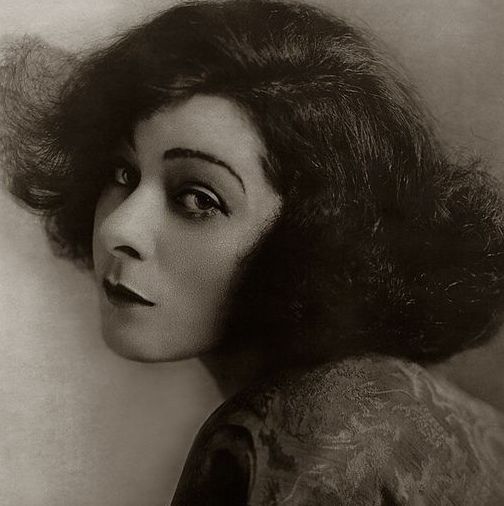
"HOT as hell. GAY as hell. TALENTED as hell. Producer, director, writer, actress. A silent era superstar who is credited with having coined the term "sewing circle" as a code-word for gatherings of lesbian and bisexual women. Has been called "the founding mother of Sapphic Hollywood" and was the owner/operator of the Garden of Alla Hotel in West Hollywood, which she bought in 1919 and sold in 1928 after deciding she wanted to go back to Broadway. In addition to starring opposite Valentino in Camille, she also had an affair with BOTH of his wives (Jean Acker and Natacha Rambova). In her day, she was one of the most influential women in the business."

"Nazimova was primarily a star during the silent film era, and her career in film started when she was almost forty. She was openly bisexual, and was engaged in two lavender marriages during her life while she carried on relationships with women (including at least one, and possibly two, of Rudolph Valentino's wives). She was brilliant and an autodidact - when she first moved to the United States from Ukraine, she spoke no English, but taught herself "in about five months" and went on to work as a screenwriter (among other things). Her predilections lay in art film, and she's credited with starring in / producing / directing one of the first American art films, the adaptation of Oscar Wilde's play Salome (1923). She has an elegant and commanding presence in all of her films, and is an absolute sensation to watch in motion."
Gif link, another gif link
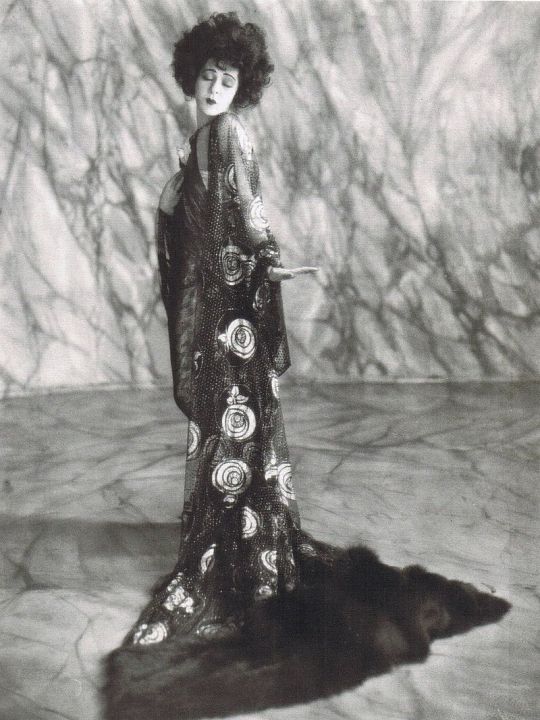
A great actress who also produced a great deal of her films, Nazimova is absolutely mesmerizing to watch. She was also bi and coined the phrase "sewing circle" for sapphic celebrities.


176 notes
·
View notes
Text
Title: Santa's Helper
Pairing: Jim Gordon/Reader
Rating: R (language, reference to role playing)
Summary: Christmas Eve at the GCPD.
Notes: divider by @firefly-graphics
Warnings: none

“I don’t know what to tell you, Y/N. It just makes sense,” Stephens said with a shrug, an amused expression on his face.
“You’re my partner,” you said pointedly. “You’re supposed to have my back.”
The Chief of Police organized the toy drive every year for the precinct, selecting one squad to deliver the presents to the children at Gotham City Orphanage on Christmas Eve. This year, it fell to the Major Crimes Unit. You had been looking forward to delivering the gifts right up until the Captain insisted that a select few were to be dressed in festive costumes instead of your uniforms. He selected who would wear what, and much to your annoyance had chosen you to dress as an elf.
“You’re already shorter than everyone in the squad, and I can’t think of anyone that has more Christmas cheer,” Stephens continued, chuckling to himself.
It was easy for him to be so nonchalant about it, he had been assigned the role of police escort. You crossed your arms over your chest, eyes glaring daggers at the elf costume sitting on your desk.
“This supposed to be some kinda joke?” Flass asked, coming out of the bathroom in his Rudolph costume.
Stephens’ laugh renewed, one hand going to hold his stomach. This time you joined in with a chuckle of your own.
“Wonder who got Santa,” Stephens asked as his giggles began to die down. He looked around the bullpen at everyone’s desk.
“I don’t see the costume anywhere,” you replied. “Maybe he’s going for the whole ‘Santa’s busy delivering other presents so he sent his elves’ vibe.”
“Nah, there’s gotta be — Oh this just keeps getting better and better!” He was nearly doubled over in laughter, looking at something over your shoulder. Flass was also in a fit of laughter, apparently unfazed by the blinked, red nose on his face.
Turning to look, you quickly pursed your lips at the sight of Jim, dressed head to toe in the signature red and white suit with a matching hat and fake beard in each of his hands.
“Laugh it up, you two, just remember who does your schedule,” Jim called out to Flass and Stephens.
Your partner's laughter didn’t let up, nor did Flass’, the former chortling, “Aw, come on, Sarge, where’s your Christmas spirit?”
Jim rolled his eyes, but as soon as his gaze fell on the costume that still sat on your desk, his eyes lit up. Looking up at you, he smirked in somewhat satisfaction. “What are you waiting for, Detective? We’re leaving in just a few minutes. Go get your costume on.”
“Sarge, I’ll work doubles everyday for a month if I can just dress in my blues.”
“Absolutely not. If I have to dress as Santa, and Flass has to wear that reindeer costume all night, you’re gonna wear yours too,” he replied, coming to stand behind you. “Besides, what good is Santa without his elf?”
You groaned and swiped the costume up, going to the bathroom to change into it.
You had to hand it to whoever purchased the costumes, the material was not at all as flimsy as you anticipated. It was actually quite warm, something you thought had to be on purpose to protect the wearer from the blistering cold of Gotham City on Christmas Eve. Even the candy cane adorned socks were warm, and the buckled shoes were sturdy and comfortable.
Looking at yourself in the mirror, you grimaced, deciding to go without the hat. You put your clothes into the package the costume had come in and came out to put it on your desk.
“Put it on,” Jim said, smirk on his face as he glanced at the hat in your hand.
“I don’t need it,” you tried to argue.
“Put. It. On.”
Frowning, you straightened out the hat in your hands and shoved it onto your head. Stephens was still laughing as he, Flass and the two other detectives on duty carried the presents out of the squad room.
“Now you,” you said, tipping your chin up at Jim.
Huffing as he tucked the Santa hat under his arm, he pulled the beard over his face, covering his thick mustache and bare chin with a fluffy, snow-white beard that fell to his chest. He pulled on the hat and put his hands out at his sides. “I look ridiculous.”
“How do you think I feel, Santa?” you asked, coming up to play with the ends of his beard.
“No, you look very cute,” he replied. “And look at it this way, at least you’re not gonna have dozens of kids trying to sit on your lap.”
You glanced around to be sure no one could hear you before stepping closer and saying, “Well, maybe later, if you’re not too tired, Santa’s Helper could have some time on your lap.”
“Not that that doesn’t sound like an amazing idea, but I think we’re supposed to give these back at the end of the night,” he replied.
“Well, that’s okay. I may have made a purchase a few weeks back,” you answered. “It’s not quite the full Santa costume, strictly speaking, they’re more like Santa shorts.”
“Shorts,” he repeated.
“Boxer briefs with white trim,” you answered. “It was supposed to be a gag gift, but then I started thinking about you wearing them and I got really turned on, so I bought something for me to wear, too.”
He arched a brow in interest. “I’m listening.”
“That will have to wait until after we deliver these presents, Santa,” you whispered into his ear.
“For Christsake, Y/N,” he mumbled as your colleagues came back in.
“We good to go, Sarge?”
“Yep!”

Delivering the presents to the orphanage had turned out to be quite the heartwarming experience. The kids had been more than grateful for the gifts, and Jim even managed to not have any of them wanting to sit on his lap.
The two of you managed to get home at around nine thirty, which was a miracle in and of itself.
“Alright, we’re home. Now can I see what you got?” Jim asked the moment the door was closed.
You chuckled at his eagerness. “Sure. I’ll bring out your shorts, too.”
“I’m gonna light the fireplace,” he said as you went into the bedroom.
You set your gun, badge and cell phone on the dresser before going into the closet and reaching behind the shoe rack pulling out the costume you’d bought and the boxer briefs you’d gotten for Jim. Laying out the underwear for him, you put your costume on, a velvet spaghetti strap red and white tank top and matching booty shorts. Taking down your hair, you ran your fingers through it to comb it out and looked yourself over in the mirror, deciding to go out barefoot.
Jim was just standing from having gotten the fire going, clapping the soot off his hands as he stood and turned toward you. His eyes slowly moved over you, taking you in from head to toe as he went up to you.
“Christ, you look good enough to eat in that,” he purred, his hands going to your waist as soon as you were within arm’s reach. Pulling you flush against him, he ran his hands over the fabric on your hips, glancing at the shorts in your left hand. “Those for me?”
“Mhm. We match,” you answered with a smirk. “You should put them on, I’m dying to see you in them.”
Leaning forward, he took your lips with his as he took the festive underwear out of your hand. Just as he began to deepen the kiss, his phone rang. You wouldn’t have thought anything of it, except your phone also began to ring. Jim groaned against your lips, pulling away to look down at his mobile. He cursed under his breath, looking back at you apologetically.
“You have got to be fucking kidding me,” you said.
“We have to, we’re on call,” he answered.
You groaned, your head falling back.
“Let’s just hurry up and go,” he said, dropping a wet kiss on your throat. “And when we get back, I’m going to devour every last inch of you.”
Humming as a shiver ran over your frame, you looked back at him. “Okay.” You went to go back into the bedroom, when he tightened his hold on you, waiting till you looked back at him.
“Leave it on underneath,” he purred into your ear.
Your eyes widened as a smile fell on your lips. “So naughty.”
“Not nearly as naughty as it's gonna get after I get you home for good. Hope you didn’t plan on sleeping, cause Santa’s got a long night planned for his little helper.”
#jim gordon x reader#jim gordon fanfic#jim gordon#the dark knight trilogy#gary oldman fanfiction#gary oldman#christmas eve#santa
25 notes
·
View notes
Text
David Baldacci Biography
David Baldacci is a renowned American author known for his best-selling novels in the thriller and mystery genres. With a background in law, his captivating storytelling has earned him a global readership.
Biography
Attribute
Details
Full Name
David Baldacci
Pseudonym
David Baldacci Ford
Date of Birth
August 5, 1960
Nationality
American
Profession
Novelist, Attorney
Genres
Suspense, Legal Thrillers
Early Life
Early Life of David Baldacci
David Baldacci was born and raised in Richmond, Virginia. He completed his high school education at Henrico High School. Baldacci went on to earn a Bachelor's degree in political science from Virginia Commonwealth University. Following his undergraduate education, he pursued a Juris Doctor degree from the University of Virginia School of Law. After completing his law degree, Baldacci practiced law for nine years in Washington, D.C. Throughout his early life, he was deeply influenced by classic mysteries, a genre that would later shape his own writing career. Today, he resides in Fairfax County, Virginia, with his family.
Family
David Baldacci Family Information
table
width: 100%;
border-collapse: collapse;
th, td
padding: 10px;
text-align: left;
border-bottom: 1px solid #ddd;
th
background-color: #f2f2f2;
Relation
Name
Information
Father
Rudolph Baldacci
Rudolph Baldacci was a trucking foreman. He played a significant role in David's upbringing, providing a stable and hardworking environment.
Mother
Joyce Rose Baldacci
Joyce Rose Baldacci had a tough upbringing and shared many stories of resilience with her children. Her experiences and storytelling influenced David's career as a novelist.
Sister
Sharon Baldacci
Sharon Baldacci is David's sister. She has supported and influenced him throughout his career. Sharon is also a writer, adding to the literary talent in the family.
Height, Weight, And Other Body Measurements
David Baldacci Body Measurements
Attribute
Information
Height
Information not publicly available
Weight
Information not publicly available
Other Body Measurements
Information not publicly available
Profession
Author (Suspense novels and legal thrillers)
Residence
Fairfax County, Virginia, United States
Family
Wife: Michelle, Daughter: Spencer, Son: Collin
Foundation
Co-founder of the Wish You Well Foundation
Wife/husband / Girlfriend/boyfriend
David Baldacci's Relationship Information
David Baldacci is currently married to Michelle Baldacci. They are co-founders of the Wish You Well Foundation, which combats illiteracy in the United States by funding adult literacy programs. The couple resides in Fairfax County, Virginia, and they have two children, a daughter and a son.
Marriage Details
Wife's Name: Michelle Baldacci
Marriage Date: Information not publicly specified
Additional Information: Michelle and David are philanthropists committed to literacy and education through their foundation.
There is no publicly available information indicating that David Baldacci has had any previous wives or girlfriends before his marriage to Michelle Baldacci.
David Baldacci, a celebrated author, has successfully balanced his professional writing career with a dedicated personal life. He has a background in law, having received his law degree from the University of Virginia School of Law, and he practiced law in Washington, D.C. before becoming a full-time author.
Career, Achievements And Controversies
David Baldacci - Career, Achievements, and Controversies
How He Became Famous
David Baldacci became famous with his debut novel, Absolute Power, which was published in 1996. The book's success was further amplified when it was adapted into a film starring Clint Eastwood. This breakthrough marked the start of his prominence in the literary world, especially in the crime and thriller genres.
How The Career Started
David Baldacci's career as an author began after he spent more than two decades writing short stories and screenplays without much success.
He earned a Bachelor's degree from Virginia Commonwealth University and a law degree from the University of Virginia School of Law, after which he practiced law in Washington, D.C. However, his passion for storytelling led him to become a full-time writer.
Popular Works
David Baldacci is known for several popular series, including:
Amos Decker series
The Camel Club series
King & Maxwell series
Will Robie series
John Puller series
His works have been adapted for both feature film and television, further solidifying his reputation as a master of crime and thriller fiction.
Awards
David Baldacci has received several accolades over his career. Notably, he won the International Thriller Writers' first-ever Silver Bullet Award. This award is a testament to his contributions to the genre and his efforts in supporting literacy through his Wish You Well Foundation, which he co-founded with his wife.
Controversies
David Baldacci's career has not been significantly marred by controversies. However, like many public figures, he has faced scrutiny and criticism at various points. Specific details on controversies are sparse and generally relate to the broader challenges and criticisms that any prolific author might encounter, such as critical reviews or debates over the content of his work.
David Baldacci's journey from a practicing lawyer to a bestselling author is inspirational. With numerous bestselling novels, film adaptations, and significant contributions to literacy, he continues to be a prominent figure in the world of crime and thriller literature.
For more detailed information, you can visit the following sources:
David Baldacci's Books in Order - Pan Macmillan
About David Baldacci - Official Website
David Baldacci's Favorite Classic Detective Films - Novel Suspects
David Baldacci - Virginia Commonwealth University
Faq
David Baldacci FAQs
body
font-family: Arial, sans-serif;
line-height: 1.6;
margin: 20px;
padding: 20px;
h1
color: #333;
.faq
margin-bottom: 20px;
.faq h2
color: #0056b3;
.faq p
color: #555;
David Baldacci is a best-selling American novelist known for his thrillers and suspense novels. He has written numerous books that have been translated into over 45 languages and have sold millions of copies worldwide.
Some of David Baldacci's most popular books include "Absolute Power," "The Camel Club," "The Innocent," "Memory Man," and "One Good Deed." These titles have been critically acclaimed and have a large fan base.
Yes, several of David Baldacci's books have been adapted into films and TV series. Notably, "Absolute Power" was made into a film starring Clint Eastwood. Additionally, there have been talks and attempts to adapt other works for the screen.
David Baldacci primarily writes in the thriller, mystery, and suspense genres. However, he has also written books that fall into other categories, including young adult fiction and historical fiction.
A complete list of David Baldacci's books can be found on his official website, through major book retailers, or on literary databases such as Goodreads. These sources provide detailed information about each book, including publication dates and series order.
0 notes
Text
Your Sweater
Connor RK800 x Reader
Summary: Song fic based off ‘Heather’ by Conan Gray
Words: 2.2k
Warnings: Angst, Unrequited Love, Graphic Imagery.
A/N: Sometimes I just listen to the lyrics of a song and a character/scenario will pop into my brain. This was one of those moments. If you wanted to see an image, this is the 'ugly sweater' I found.

Finally home, Connor sits in the lone navy velvet lounge chair facing the wall of windows lining his apartment. Fingers absentmindedly rubbing the green polyester fabric of your sweater, he recalls the night. Of course, with his hardware, he’s perfectly able to recollect the details. It was a Saturday, December 3rd, 2039.
Though most junior detectives and officers take the holidays off, it wasn’t a holiday, at least not in the United States. With Hank having to undergo inguinal hernia surgery on Monday, it was your idea to throw him a celebratory going away party. After hearing his recovery time won’t allow the Lieutenant back in the office for at least a month, you insisted on some sort of celebration. What he hadn’t anticipated, albeit he should have suspected, the party was themed around the holidays. “What do you mean? Hank didn’t tell you? He said he would!”
“Must have slipped his mind,” Connor responds with a gentle smile hoping to pacify the error on the Lieutenant’s behalf.
“Here, then take this-” you begin to peel the green sweater off your body.
“-I couldn’t. It’s yours. You’ll be cold if you go out. Temperatures are supposed to get down to freezing tonight,” he tries to refuse.
“-It wouldn’t be a proper first ugly sweater party if you don’t have an ugly sweater! It’s fine, Con, really. I’ve been to a ton of these.” Submitting, he lets you place the sweater in his hand. It’s only from your insistence that he puts it on. He agrees that if one were to properly engage in this ‘ugly sweater contest’ then one would indeed need an ‘ugly’ sweater, though by what standards those are measured is unclear. “It looks better on you, anyway.”
That compliment goes straight to his thirium pump, blue blood flushing his cheeks. Looking down at the sweater, his fingers run over the hem as he admires it. The striped sleeves remind him of the candy canes hooked over some officer’s mugs sitting at their desk as a sort of communal candy bowl. In the middle of his chest is a reindeer, a red nose which he recognizes from the movie you had been discussing sometime after Thanksgiving: Rudolph the Red-Nosed Reindeer. You claimed it was a classic, a movie he absolutely must see over the holidays to get into the festive mood. Though he’d looked up the premise in order to understand your references, he mentally put it on his list of movies to watch.
“So what makes it ugly?” Connor wonders, hazel eyes roaming over the sweater, inspecting the snowflakes in the background, as well as the incredibly cheesy words ‘Oh Deer’ placed over the reindeer’s head. He doesn’t miss the amused look you’re trying to hide in response, your deep, animated eyes flitting away for a moment as he can practically see the cogs turning in your mind.
“It’s punny,” you joke, the smile on your lips eliciting a stirring sensation in his gut he’s slowly grown accustomed to around you. Lost in your facial expression, he misses the movement of your arm before he feels the (relatively) gentle punch of your fist against his arm. Unable to help from mirroring the smile on your face, Connor can’t help the laugh that escapes his lips.
“Yeah, but... I wouldn’t call it ugly?” Though his observations may come across as clueless to you, he never feels judged. If anyone was willing to answer his questions during the time he’s worked at the DPD, it’s you. “I don’t know that I would pick it out myself, or-“
A loud groan cuts off his thoughts, Connor’s eyes drawn to Gavin as he interrupts. “-Yeah, but it’s stupid, and something I could most definitely see you picking out, so- ugly fits,” he butts in, slinging his arm around your frame as he stands across from him.
Though Reed’s words could be considered rude, it isn’t that which causes his thirium pump to feel as though something is tightening around it- squeezing it. He watches as your eyes seem to sparkle as they shift to stare up at your boyfriend: Gavin. Even if your relationship is fairly new, Connor can’t stand the way you look at him. How Reed won you over? He’ll never know. It didn’t seem right, it didn’t feel right, yet... it’s reality. No matter how much he didn’t want to accept it- you and Gavin- he was still your friend, and so he has to be supportive. Right? That’s what a friend would do. He knows that’s what you’d say. A disgusting feeling settles in his stomach, and Connor knows he’s ruminating again, but it isn’t until he watches as Gavin leads you by the waist away that Connor comes back to reality.
“That wasn’t very nice, Gav,” he hears you chide the Detective as the two of you walk away.
He tried to socialize, to act normal, to joke with Hank, drink his thirium juice, a newer invention multiple companies have come out with as the strive to incorporate androids into society has been pushed forward. Yet, Connor’s eyes would drift, he’d find himself staring at you and Gavin. Drinking and laughing by the punch bowl near the break room, it hurt to watch Gavin strip off the sweater he’d been wearing to give it to you. Even if it seemed that Gavin was more concerned about covering up the skin unhidden by the tank top you’d been wearing under your sweater, you didn’t seem to refute his offer more than once before giving in so easily.
Whatever happiness that’d been in his eyes vanishes as he drops his head down to look into his cup. Standing among his chatting colleagues, he doesn’t really listen anymore, their voices drowning into murmurs as he sinks within himself, feeling. Androids don’t really get cold, not as easily as humans, anyhow... and despite your sweater, he swears he can feel himself get colder inside.
Hand in hand, the two of you trot over as Chris gathers everyone around to vote for the winner of the ugly sweater contest. Everyone, pen and paper scraps in hand, begin to write down their vote. Mind elsewhere, Connor can’t decide on a favorite. Is it supposed to be my favorite? Or the one I like least? Eyes drifting over to you, hazel orbs take in the ugliest sweater, in his opinion. Reed had gone for a depiction of Santa Claus defecating down a chimney, a newspaper in hand. If it were the former, the sweater he likes most... then that would be Stacy; Santa Claus riding a T-Rex. Sure, it seemed somewhat random, but the abstract idea only made it funnier to the android.
Debating which sweater to write down, the movement a few feet away catches his attention. While he’d been zoning out, he’d been staring at you; caught, your eyes meet his for a moment, lingering before your lips draw up into a smile. You break the eye contact first, dropping your head as you go to write down a name on your slip of paper pressed against Reed’s shoulder for support.
Chris quickly gathers up the papers, Connor scribbling a name down before shoving it in the Officer’s hands. Put into a bowl, the party resumes as they take it away to count the votes. Somewhat reassured by the friendly look you’d given, Connor doesn’t worry about Gavin taking you away from your friendship. You wouldn’t let that happen. Of course not, he tells himself. Lifting his cup to sip on the thickly sweet thirium juice, he actually finds himself able to enjoy his friend’s company. Classic Christmas music plays throughout the station, the shiny tinsel strung along the walls and dividers between the desks.
“Do you think we’ll get as much snow as last year? Or more?” Hank throws out a topic, everyone proffering their opinion on the matter considering the ever-changing climate. Wrapped up in the conversation, Connor almost entirely forgot about the ugly sweater contest until Chris happened to stand up on one of the desks and holler for everyone’s attention again. Some of his friends make sure he’s steady, most everyone seeming to have a slight buzz on now that it’s been a few hours.
“This year’s ugly sweater goes to- can we get a drum roll, please?” Chris announces, Wilson, coming in clutch as he drums his hands against the desk harder than expected. Everyone quiets as they wait, Wilson’s drumming getting louder. “Connor!” The room cheers, the music resumes, and people go back to conversing as he stands still. Apparently, the surprise was evident on his face as he receives multiple congratulations and a few teasing remarks.
“Didn’t think it’d be you, huh?” Hank laughs, nudging him with his elbow.
“We put together a stocking with a bunch of crap inside. Gift cards, chocolate, uh... some pens and whatnot.” Chris hands over the stocking, patting Connor on the back. “Congratulations, man.” As Chris leaves, Hank steps closer.
“It’s getting late- I think we should head out if you’re ready. I’m gonna go toss this,” he raises his empty beer for emphasis. With a nod, his hazel eyes drift down to the stocking, a happy feeling forming as the realization settles in. He’d won! Though he isn’t sure if that’s a good thing or not, the entire department getting together to give him a gift definitely felt nice.
“Congratulations, Connor,” your soft, excited voice causes him to raise his gaze again, a smile starting to form until he notices it’s not just you.
“Congrats, I guess,” Gavin states with a small forced smile on his lips, no doubt from your persuasion, that much Connor is sure of. Tipping his beer toward the android, Connor nods in appreciation, lips parting as he’s about to respond. “I’m gonna go grab a smoke, then I think we should dip. No use hanging around- party’s almost dead,” Gavin beats him to it. As the rugged man turns to exit, catching up with a few friends and colleagues boisterously chatting, the cheers and whoops of surrounding partygoers go deaf on his ears.
“I’m just glad I could at least get him to come over and say that,” you joke. Though a seemingly saddened smile appears on your lips, it’s quickly erased as an expression of joy replaces it. “I was hoping you’d win! I voted for you. I don’t think it’d be any fun if Person won again!”
A chuckle emanates from the android, Connor smiling down at you, though the thought doesn’t fade from the back of his mind. Eyeing the stocking, he has to ask. “It... isn’t a bad thing, or is it?”
“Op! Guys, look!” Wilson taunts, having just approached the two of you. Eyes raising, Wilson holds a bundle of mistletoe tied with a red ribbon around the height of his forehead. “It’s a tradition, you gotta!” Speech slightly slurred, others join in on cheering as Connor now realizes why they’d been cheering- Wilson had been going around getting people to participate in this ‘tradition’.
A sinking feeling gnaws at his artificial stomach, Connor dreading this moment. Everyone knew that you and Gavin were a thing now. It wasn’t some sort of secret. Why would he do this? Was this some sort of joke? Connor shoots down whatever hope he’d had within, knowing that despite your love for the holidays and their fun traditions, he can’t help but think: why would she ever kiss me?
Voices drowned out by the cacophony of cheers, Connor doesn’t know how to react. In an instant your hand is on the back of his neck, pulling him down enough to place your lips against his for a good, solid moment. Plush, soft, warm, glossy lips press against his- Connor’s eyelids flutter shut as he remains still. Heart thumping in his chest wildly, the cheering quickly dies down as Wilson and whatever participants watching move onto the next people.
As the two of you part, Connor quickly shifts the stocking in his hands, taking a stronger grip on it as he’d almost dropped it and spilled the contents within. Unmoving, it feels as though time has stopped. Watching your eyes flutter open, a smile spreading across your lips as you stare up at him with that little twinkle in your eye... Connor swears he’s died.
“I have to go, I’m sorry-“ looking over your shoulder, Connor realizes you’re looking in the direction Gavin had gone. “And it’s a good thing, don’t worry!” Turning to leave, Connor nods in understanding, worries diminished. He, too, turns to leave. Hazel eyes find his stocking again, a smile finding its way onto his lips as he now knows that- not only is it a good thing, but you’d voted for him. You wanted him to win the contest. With both the win, the stocking, and the kiss, butterflies fill his stomach.
“Oh!” The sound of your voice catches him off guard. Straightening, he turns around to see that you’d stopped only a few feet away. For some reason, he can’t read the expression on your face. It shouldn’t be possible- he’s an android, he’s literally programmed to be able to detect emotion and intention. “Merry Christmas, Connor.” This time he doesn’t turn away. Instead, he watches your fleeing image. Stocking held against his chest, he whispers a ‘Merry Christmas’ that was meant for you.
#connor rk800 x reader#gavin reed x reader#song fic#my writing#dbh connor x reader#connor x reader#angst#dbh angst
266 notes
·
View notes
Text
intellectual guesswork.
Aaron Hotchner x Gender Neutral Reader
a/n: another ajf update that requires absolutely no context to enjoy! i love you all so much. send some extra love to your favorite writers this week :)
one quick thing - if you’re on my taglist, please consider dropping a reply or a reblog! i love to see what you all think, and it encourages me to keep going :) it’s also getting a bit long, and i want to make sure my mutuals and people who engage are seeing everything - tumblr sometimes has a hard time with a lot of mentions.
words: 1.6k
warnings: none!
summary: “ignorance of the law excuses no man - from practicing it.” - addison mizner. au!may 2008
masterlist | a joyful future masterlist | ajf faq | taglist | what do you want to see next?
edited: january 12th, 2021
You all settle into one row. Aaron’s on the end beside you, looking very sharp in a crisp black suit, his favorite Rolex, and a settled kind of confidence you’ve only seen in him a few times. It’s like he’s in his natural habitat.
Aaron’s record as a federal prosecutor speaks for itself, of course, but you’ve never seen him in action. As often as they can, the bureau’s leadership sends him in as an expert witness. This time, the case happens to be one of yours. The judge hasn’t required a sequestration for Aaron, so you get the treat of sitting together in the courtroom.
He’s scoffed and mumbled snide remarks under his breath all morning. You’re just itching to see him get up on the stand and give this joker an education.
Emily leans over, whispering in your ear. “I promise you’ve never seen anything like this before. Hotch is going to rip this clown to shreds.”
You stifle a laugh and look over at Aaron. He heard her. Leaning toward you, he murmurs, “All my JD does is collect dust. When I use it, I’d like to enjoy it.”
“Your Honor, the prosecution would like to call our expert witness, Supervisory Special Agent Aaron Hotchner, to the stand.”
He takes a breath and rises, buttoning his suit jacket and crossing the courtroom. His presence commands respect and everyone in the courtroom seems to shrink before him.
The prosecution’s questions go over smoothly, and the defense attorney stands with an unreasonable amount of confidence.
Emily leans over. “He thinks he can get Hotch with at least one of these questions, and he might. But just watch.”
You nod, taking everything in.
“So you’ve stated that it was your profile of the killer that led you and the police to my clients door that night.”
“Behavioral analysis was a factor in our investigation, yes.”
Without hesitation, the attorney follows up. “And was behavioral analysis also a factor in the Olympic Park bombings case in Atlanta?”
“Yes, it was.” Aaron’s eyes and tone never waver, no hint of arrogance or cheek.
“And was that suspect you identified,” the attorney asks, far too aggressively, “Richard Jewell, ever convicted of the bombings?”
The prosecution objects, and you watch Aaron. Every part of him observes the proceedings with an outwardly detached interest, but his eyes are alive - strategizing and anticipating. It’s like you can see the wheels turning as the lawyers bicker.
The judge ends the squabble. “I’ll allow it.”
Aaron, now with permission, answers simply, “No, he was not convicted.”
“Because he was innocent. Your profile led you to the wrong man.”
Oh, give me a break. It takes everything in you not to scoff and you can feel Emily’s eye roll.
“Jewell was not the perpetrator, but if you look at the real Olympic Park Bomber, Eric Rudolph, you’ll see that our profile was dead-on.”
Dead-on indeed, Aaron.
“Well, how about we look at the Baton Rouge Killer? Your unit said that he was white and living in the city. He was Black and from the suburbs.”
Aaron’s eyes narrow and you feel Spencer shift beside you. Emily shakes her head. “Don’t worry,” she whispers. “He always recovers, never in the way you’d expect.”
“How do you know?”
Emily’s face pulls into a little smile. “I’ve read the transcripts. Hotch is terribly clever.”
“You said that Dennis Rader, the B.T.K. Killer,” the attorney continues, “was divorced and impotent. He turned out to be married with two kids.”
JJ huffs, and you hear her whisper to Spencer, “Can we quit with the sermon?”
His lips turn up. “Just wait.”
Dave leans over and stares them down over Derek. Stop talking.
All of you look down at your hands like chastised children, but your gaze floats back to Aaron right away.
The prosecution objects again, this time on the grounds of preaching. The judge forces a question, and the attorney turns back on Aaron.
“Having been wrong on those cases, isn’t it possible that you were wrong about Brian Matloff?”
“No.” Your chest squeezes. He’s completely firm in his denial.
How does he do that?
“Fact is,” the attorney continues like Aaron didn’t speak at all, “behavioral analysis is really just intellectual guesswork. You probably couldn’t tell me the color of my socks with any greater accuracy than a carnival psychic.”
“Objection!”
Her outburst is unnecessary. Aaron has a plan. His eyes track to you as if to check in. Are you paying attention?
If you weren’t watching before, you’re certainly watching now. Always.
“Withdrawn.”
“Charcoal grey.” His flat assertion makes you gasp and you immediately cover your mouth with your hand to stifle the sound.
The attorney turns around. “Well, look at that,” he exposes his socks to the court, and they are, in fact, charcoal grey. “He got one right.”
Aaron’s not finished. “You match them to the color of your suit to appear taller. You also wear lifts and you’ve had the soles of your shoes replaced. One might think you’re frugal, but in fact, you’re having financial difficulties.”
You do your best to school your expression and remove your hand from your mouth. Checking down the row, you see six smirks watching the witness box.
“You wear a fake Rolex…”
And you’d know.
“...because you pawned the real one to pay your debts. My guess would be to a bookie.”
Is he smiling?
“I took this case pro bono.” There’s tension in Mr. Charcoal Grey’s voice. You can hear it behind the false confidence and it pulls a smile from you. “I am one of the most successful criminal attorneys in the state.”
Hotch continues, completely bypassing him. “Your vice is horses.” There’s definitely a little smile on his face now. “Your Blackberry’s been buzzing on the table every twenty minutes, which happens to be the average time between posts from Colonial Downs. You’re getting race results.” Your smile gets wider, and Emily grabs your hand.
“Just watch.”
“And every time you do, it affects your mood in court, and you’re not having a very good day.” There’s something that looks almost like concern on Aaron’s face, but you know it’s nothing if not facetious. He’s ripping this poor man to shreds without changing a single thing about his presentation.
I love -
Don’t finish that thought.
Why not?
Remember how he’s freshly divorced?
I know, but have you seen him?
“That’s because you pick horses the same way you practice law -”
You lean forward and Emily follows, her thumbnail between her teeth.
The final blow.
“- by always taking the long shot.”
If this was any other setting, you’re sure the entire team would be on their feet, shouting and jeering. But alas, you’re in court, so you settle for a wide smile and a suppressed laugh. Amused brown eyes meet yours from across the room and you shake your head just the tiniest bit. I can’t believe you.
His lips twitch.
“Well, you spin a very good yarn, Agent, but as usual, you’ve proven nothing.” He’s just trying to recover something, anything left of his dignity. He fails, miserably.
“If I’m not mistaken,” Aaron says, his eyebrows raised just a little, “the results from the fifth race should be coming through any minute.”
Just then, his Blackberry buzzes on the defense table. “Why don’t you tell us if your luck has changed?”
You raise your hands to your face to cool the rising heat in your cheeks.
“Your honor, this is - “
The judge takes matters into his own hands. “What do you want me to do? Either show us your Blackberry or cut him loose, counselor.”
Hotch and the defense attorney share a loaded look. It’s a battle of wills.
Aaron wins.
“Nothing further.”
+++
When you all leave the courthouse, you practically latch onto Aaron’s arm, completely floored.
“How did you do that?”
He laughs and Derek jumps up beside him, shaking his shoulders. “Come on, Hotch. That was incredible.”
“Why have a law degree if you aren’t going to use it?”
+++
He offers you a ride home later that evening and you take him up on it. You’re both still in the car, idling in front of your house.
“That really was impressive today,” you admit, your eyes on your hands.
You can feel his soft smile rather than see it. “Thanks. I know it didn’t quite go the way we wanted as far as the case itself, but there’s more to come.”
“It’s never as bad as it looks in the first couple of days.”
“Exactly.” He sighs. “Thanks again for being there today. It’s…” his lips twist as he thinks, “nice to have the team around.”
You reach out, squeezing his forearm before immediately letting him go. “Of course. We’ll always be there for you. Plus, there’s nothing better than watching you tear blowhard lawyers to shreds in a court of law.”
“I’m not sure that’s exactly how it went.”
“You’re kidding!” You laugh. “That’s just what happened. The man left without half his soul! You absolutely tore it from his body.”
The pair of you quiet, and you move to get out of the car. He stops you with a hand over yours as you unclip your seatbelt. “Really. Thanks for being there today.”
“I can’t emphasize this enough - it was my pleasure.”
Enough of a pleasure as it was, his smile in the dark of the car is the best part of your day.
+++
tagging: @arganfics @quillvine @stxrryspencer @agenthotchner @wandaswitxh @hurricanejjareau @fics-ilike @ange-must-die @ughitsbaby @rousethemouse @criminalsmarts @shrimpyblog @genevievedarcygranger @ssaic-jareau @good-heavens-chris-evans @davidrossi-ismydad @angelsbabey @gublergirls @writefasttalkevenfaster @venusbarnes @hotchsflower @micaiahmoonheart @ogmilkis @thatreallyis-americas-ass @marvels-agents100 @hotchslatte @risenfox @mrs-dr-reid @captain-christopher-pike @joemazzello-imagines @pinkdiamond1016 @sebbybaby0 @pan-pride-12 @hotchlinebling @lee-rin-ah @sunshine-em @word-scribbless @jdougl-love @sageellsworth05 @nohalohoseok @giveusbackourbucky @writerxinthedark @bauslut @yourlovelynewsbian @sparklingkeylimepie @aili28 @kingandrear @reader4027 @spnobsessedmemes @rogers-mouth @dreila03 @forgottenword @aaronhotchnerr @ssa-morgan @hotchnersgoddess @buckybau @phoenixfyre374 @sana-li @tegggeeee @abschaffer2 @ssacandi-ass-prentiss @dontkissthewriter @ellyhotchner @lotties-journey-abroad @mrs-joel-pimentel-23-25 @laneygthememequeen @ahopelessromantic @violentvulgarvolatile @andreasworlsboring101 @mooneylupinblack @ssareidbby @violet-amxthyst @bwbatta @roses-and-grasses @lcvischmitt @capricorngf @missdowntonabbey @averyhotchner @mandylove1000 @garcia-reid-lovechild @cevanswhre @colbyskoalas @qvid-pro-qvo @jeor @spencers-hoodrat @infinity1321
#aaron hotchner x reader#aaron hotchner#hotch x reader#hotch#aaron hotchner imagine#criminal minds x reader#criminal minds fanfiction#criminal minds imagine#criminal minds#tali writes fanfiction#tali talks cm#a joyful future#a joyful future fanfic
619 notes
·
View notes
Photo

Ghosts of Hollywood
Marilyn Monroe
The Hollywood Roosevelt Hotel on Hollywood Boulevard is said to be the current residence of several ghosts of popular film stars. Marilyn Monroe, the glamorous and funny star of such pictures as Some Like It Hot and Gentlemen Prefer Blondes, was a frequent guest of the Roosevelt at the height of her popularity. And although she died in her Brentwood home, her image has been seen on several occasions in a full-length mirror that once hung in her poolside suite. The mirror has been relocated to the hotel's lower level by the elevators.
Montgomery Clift
Another respected star who died before his time, Montgomery Clift, was a four-time Oscar nominated actor who is best known for his roles in A Place in the Sun, From Here to Eternity and Judgment at Nuremberg. His ghost has also been seen at the Roosevelt. According to some of the hotel's staff, Clift's spirit haunts room number 928. Clift stayed in that suite in 1953, pacing back and forth, memorizing his lines for From Here to Eternity. Loud, unexplained noises have been heard coming from the empty suite, and its phone is occasionally found mysteriously off the hook.
Perhaps it's fitting that the Hollywood Roosevelt should be the stirring place of celebrity ghosts since it was the site of the very first Academy Awards ceremony in 1929. In fact, the Blossom Ballroom, where the ceremony was held, has an unexplained cold spot - a circular area measuring 30 inches in diameter that remains about 10 degrees colder than the rest of the room.
Harry Houdini
Houdini is best known as a magician and escape artist, of course, but at the height of his fame he was also drawn to Hollywood, where he made a handful of silent films from 1919 to 1923. With such titles as The Man from Beyond and Haldane of the Secret Service (which he also directed), the films were not regarded well enough to give him much of a Hollywood career. Houdini's interest in the occult was well known, and although he earned a reputation as a masterful debunker of séances, he earnestly sought contact with those who have passed on to the other side. Shortly before his death, Houdini made a pact with his wife Bess that if he could, he would return and make contact with her from the other side. Perhaps he truly has attempted to return. Some claim to have seen the ghost of the great Houdini walking around in the home he owned on Laurel Canyon Blvd. in the Hollywood Hills. Film historians Laurie Jacobson and Marc Wanamaker, in their book Hollywood Haunted, dispute this story, saying that "Houdini most likely never even set foot in the Laurel Canyon mansion he is said to haunt."
Clifton Webb
Clifton Webb was a very popular star of the 1940s and '50s, earning two Oscar nominations for his roles in Laura and The Razor's Edge. He may be best known for his portrayal of Mr. Belvedere in a series of films. It's not too often that a ghost haunts the place in which the person is buried, but this seems to be the case for Webb. His ghost has been seen at the Abbey of the Psalms, Hollywood Memorial Cemetery, where his body is interred. But it seems to be a restless spirit, as his ghost has also been encountered at his old home on Rexford Drive in Beverly Hills.
Thelma Todd
Thelma Todd was a hot young star in the 1930s. She was featured in a number of hit comedies with the likes of The Marx Brothers, Laurel and Hardy, and Buster Keaton. But that all ended in 1935 when Todd was found dead in her car, which was parked above the café she owned on the Pacific Coast Highway. Strangely, her death was ruled an accidental suicide, but many suspected murder and a coverup by powerful Hollywood figures. The building that once housed the café is now owed by Paulist Productions, and employees have reportedly witnessed the starlet's ghost descending the stairs.
Thomas Ince
Ince is considered one of the visionary pioneers of American movies. He was one of the most respected directors of the silent era, best known, perhaps, for his westerns starring William S. Hart. He partnered with other early Hollywood giants such as D.W. Griffith and Mack Sennett, and founded Culver Studios, which later became MGM. Ironically, Ince's death overshadowed his film legacy. He died aboard William Randolph Hearst's yacht in 1924, and although the official record shows the cause of death as heart failure, the hot rumor is that he was shot by Hearst in a fit a jealousy over Hearst's wife, Marion Davies. Ince's ghost - as well as several other ghostly figures - have been seen in the lot that was once Culver Studios. Film crew members have seen the specter of a man matching Ince's description on several occasions; in one instance, when the workers tried to speak to the spirit, it turned and disappeared through a wall.
Ozzie Nelson
Ghosts and hauntings are the last thing that come to mind when you think of the perpetually cheerful Ozzie and Harriet Nelson. The couple, with their real-life sons Ricky and David, were stars of the long-running sitcom "Ozzie and Harriet," noted for its good-natured, gentle humor. Yet poor Ozzie doesn't seem to be as contented in the afterlife. Family members, it is said, have seen Ozzie's ghost in the family's old Hollywood home, and it always appears to be in a somber mood. Perhaps he's unhappy about how another Ozzy and his family have gained notoriety on TV.
George Reeves
From 1953 to 1957, George Reeves was TV's Superman. Reeves had been around Hollywood for a while, playing bit parts in such films as Gone with the Wind and dozens of B-movies, but it was "The Adventures of Superman" on TV that brought him fame. Reeves died of a gunshot at his home in 1959. The official cause of death was suicide, but that conclusion has been hotly disputed, with some believing that Reeves was murdered. Whether it was suicide or murder, Reeves ghost has been seen in his Beverly Hills home. A couple claims to have seen the ghost of Reeves - decked out in his Superman costume - materialize in the bedroom where he died, after which it slowly faded away.
Others believe that Reeves succumbed to the "Superman curse," in which those associated with the fictional character over the years allegedly have met with disaster or death. But is there really a curse?
More Celebrity Ghosts
Rudolph Valentino - This silent film heartthrob has been seen in the bedroom and stables of his old Hollywood home.
Jean Harlow - The spirit of this blonde bombshell is said to haunt the bedroom of her home on North Palm Drive, where her husband allegedly used to beat her.
Mary Pickford - This legend of the silent era - actress, writer and producer - was co-founder of United Artists with her husband Douglas Fairbanks and Charlie Chaplin. Comic Buddy Rogers, who lived in the house Pickford once owned, saw her ghost appear in a white ruffled dress.
Grace Kelly - Princess Stephanie of Monaco believes that the ghost of her mother, Grace Kelly, helped her write a song from the spirit world.
Celebrities Who Have Seen Ghosts
Nicholas Cage - This Oscar-winning actor (Leaving Las Vegas) refused to stay in uncle Francis Ford Coppola's home after seeing a ghost in the attic. (Cage was also cast as Superman in director Tim Burton's film project, which was never made.)
Keanu Reeves - The star of The Matrix films and Devil's Advocate was just a kid in New Jersey when he saw a ghost that took the form of a white double-breasted suit come into his room one night. He wasn't imagining it; his nanny saw the phantom, too.
Neve Campbell - She's been in more than her share of paranormal-themed movies (The Craft, Scream), but she's had real-life encounters as well. A woman was murdered in the house she now lives in, and friends have seen her ghost walking around.
Matthew McConaughey - This popular actor (Contact) says he freaked out the first time he saw the ghost of an old woman, whom he calls "Madame Blue," floating around his house.
Tim Robbins - Robbins, who was nominated for an Oscar in Mystic River, didn't see ghosts, but strongly felt their presence when he moved into an apartment in 1984. Following his instinct, he moved out the next day.
Hugh Grant - British romantic comedy lead Hugh Grant (Love Actually) says he and friends have heard the wailing and screaming of some tormented spirit in his Los Angeles home. He even speculates it might be the ghost of a former resident - Bette Davis.
Dan Aykroyd - The Ghostbusters star (and Oscar-nominated for Driving Miss Daisy) has long had a fascination with the paranormal. He believes his home, once owned by Cass Elliot of The Mamas and The Papas, is haunted. "A ghost certainly haunts my house," he said. "It once even crawled into bed with me. The ghost also turns on the Stairmaster and moves jewelry across the dresser. I'm sure it's Mama Cass because you get the feeling it's a big ghost."
Sting - Rock star Sting (Lock, Stock and Two Smoking Barrels) and his wife Trudie have seen ghosts in their home. "I was absolutely terrified," he said. "I now believe those things are out there, but I have no explanation for them."
Jean Claude Van Damme - The Belgian action star (Timecop), also known as "Muscles from Brussels," swears he saw a ghost in his bathroom mirror while he was brushing his teeth.
Richard Dreyfuss - He won an Oscar for The Goodbye Girl, but at one time had a cocaine problem. Visions of a ghost, he said, helped him kick the habit. "I had a car crash in the late 1970s," Dreyfuss said, "when I was really screwed up, and I started seeing these ghostly visions of a little girl every night. I couldn't shake this image. Every day it became clearer and I didn't know who the hell she was. Then I realized that kid was either the child I didn't kill the night I smashed up my car, or it was the daughter that I didn't have yet. I immediately sobered up."
Ethan Hawke and Uma Thurman - This Hollywood couple was forced to flee their "dream home" in Sneden's Landing, N.Y. when it became all too apparent that it was haunted. They still are reluctant to talk about their frightening encounters.
Belinda Carlisle - This pop singer and founding member of The Go-Gos, who appeared in Swing Shift and She's Having a Baby, says she saw a "misty shape" hovering over her as she lay in bed one night. She also says that when she was 17, while nodding off to sleep in a chair in her parents' home, she levitated and had an out-of-body experience.
Elke Sommers - This German-born actress, who appeared in the 1966 film The Oscar, claims to have seen the ghost of a middle-aged man in a white shirt in her home in North Beverly Hills. Guests in her home have also seen the specter. So much paranormal activity was reported in the house that the American Society for Psychical Research was brought in, and which verified the unexplained events. The severely haunted house was bought and sold more than 17 times since Sommers vacated it, and many have reported ghostly phenomena.
Paul McCartney - Ex-Beatle and Oscar-nominated songwriter ("Live and Let Die") says that he, George Harrison and Ringo Starr sensed the playful spirit of John Lennon when they were recording Lennon's song, "Free As A Bird" in 1995. "There were a lot of strange goings-on in the studio - noises that shouldn't have been there and equipment doing all manner of weird things. There was just an overall feeling that John was around."
12 notes
·
View notes
Note
Yeah the football thing is never going to happen the other day my dad was awks if he had any allergies and he instinctively said man united so that’s what I grew up with so never gonna happen 😂 omg Rudolph absolutely doesn’t have to go as hard as it does!!! But yeah jingle bells is actually proper dodgy when you read the full lyrics makes me a bit uneasy! My favourite song to sing as a kid tho was the gym away in a manger would just whack that out whenever 😂
Your dad’s a legend tbh 😂 mine was the same tho, when my sister said she supports Liverpool he couldn’t believe it, he wondered how could it possibly go so wrong!! But for some reason there is always that one family member who supports the rival 😂
Omg I gotta say this is where my knowledge of christmas songs stops (shameful ik) i guess swing low sweet chariot was alright too and then there was silent night which i thought was kinda boring? I had to google your last song 😂
1 note
·
View note
Photo

June 21, 1957
✔ Arrest Of Rudolf Abel
On June 21, 1957, Soviet intelligence officer Rudolf ABEL was arrested in the United States, having started working as an illegal immigrant there in 1948.
Abel settled in Brooklyn under the guise of an artist-photographer. His contact betrayed him. The court sentenced our intelligence officer to 30 years in prison.
The charges against him were completely unsubstantiated, it was based only on the testimony of a traitor Gajanana. (Rudolf Abel refused to testify at all and remained silent throughout the trial.) About what kind of witness Heyhanen, lawyer Donovan vividly said at the trial:
"When evaluating the testimony of this witness, constantly ask yourself the question: is he telling the truth or a lie, and maybe so serious a lie that it can save his own skin. What he tells, I believe, can fairly be described as a well-rehearsed story. With the exception of the "evidence" presented by the most pathetic of the witnesses who ever appeared in court, there is no evidence in the case that mark (Abel's alias.-S. T.) passed on information affecting US national security and secrets. There is simply no such evidence in the case. However, based on the" evidence " of Heyhanen, you are being asked to send a man, possibly to his death. But even a dog you kill only if it is proved that it is rabid...»
Nevertheless," civilized Themis " sentenced Abel to 30 (!) years in prison. Of course, any meetings with relatives and friends were out of the question. On the contrary, representatives of the Supreme court tried to put pressure on Abel's "family feelings" to break him. At the trial, a cynical spectacle was played out, which caused outrage even among the most experienced American journalists.
At one meeting, eight letters to Abel from his wife and daughter were read out in microfilm form. This tape Abel managed to throw in the trash at the Latham hotel at the time of his arrest, but the FBI later found it and subjected it to research. The letters of the daughter were written in English, the letters of the wife-in Russian.
Warm, heartfelt, intimate letters described Abel as a devoted husband and father. They convinced of the heartfelt closeness and loving attitude of his wife and daughter to Rudolf Ivanovich. The public reading of personal letters was met with disapproval in the courtroom, as an anti-human act, insulting the honor and dignity of a person. But it caused the majority of those present and a wave of respect for our scout. "As the judge's clerk droned through the letters," wrote a correspondent for an American magazine, " the steel armor of Abel's self – discipline nearly cracked. His face flushed, and his shrewd, deep-set eyes filled with tears."
Of course, Abel was in great pain at that moment. But this is exactly what the torturers were counting on. However, it was not possible to break the "iron Rudolph".
They also "broke" him in prison: they created difficult living conditions, settled him together with recidivists, and most importantly – banned correspondence with relatives (what kind of meetings at the table with caviar and soda!). Defense attorney Donovan tried to defend the client's rights in higher courts and received the following letter from the us Department of justice:
"The Ministry has made a decision of principle: to deprive Abel of the privilege to correspond with anyone, including those acting as his wife and daughter... This is our decision based on the belief that giving Abel – a convicted Soviet spy – the opportunity to provide... correspondence with people from the Soviet bloc countries will not be in our national interests."
"When I went to Abel's cell in the basement of the courthouse after the verdict, he was waiting for me, sitting at ease in a wooden chair and puffing on a cigarette. Looking at him, you would think that this man had absolutely no worries... At this moment, such cold composure of a professional seemed to me supernatural."
From the memoirs of lawyer Donovan
Later, Abel wrote to Donovan about the court's decision:
"It didn't surprise me. I did not believe that the case would be considered on the basis of the law. I see it as a political decision."
1 note
·
View note
Text
A Guide to the Case For and Against Removing Trump https://nyti.ms/2RfFJIv
A GUIDE TO THE CASE FOR AND AGAINST REMOVING TRUMP
By Weiyi Cai and Alicia Parlapiano | Published Jan. 22, 2020 | New York Times | Posted January 22, 2020 |
On Wednesday, House impeachment managers are expected to begin their opening arguments for the articles of impeachment against President Trump. Later this week, the president’s defense team is expected to portray the case as invalid and offer alternative explanations for the behavior underlying the charges.
Here are the key excerpts from the impeachment articles and a summary of how the two sides diverge on the evidence, based on legal briefs, reports from the impeachment inquiry and public statements.
ABUSE OF POWER
The first article of impeachment written by House Democrats alleges that in order to benefit his re-election, Mr. Trump used the power of his office to solicit Ukraine to announce investigations into his political rivals.
EXCERPT FROM ARTICLES OF IMPEACHMENT:
“President Trump — acting both directly and through his agents within and outside the United States Government — corruptly solicited the Government of Ukraine to publicly announce investigations …”
EVIDENCE FOR:
In a July phone call, immediately after a discussion of military aid, Mr. Trump asked President Volodymyr Zelensky of Ukraine to “do us a favor” and pursue investigations that could give him personal political benefits.
Mr. Trump instructed officials to work with his personal lawyer Rudolph W. Giuliani on Ukraine matters. A new set of documents shows that Mr. Giuliani expressed to Mr. Zelensky that he was working with the president’s “knowledge and consent.”
One witness said that Mr. Giuliani was representing Mr. Trump’s desires when he demanded that “Ukraine make a public statement announcing investigations of the 2016 election/DNC server and Burisma.”
REPUBLICANS HAVE ARGUED:
There was no explicit quid pro quo in the reconstructed transcript of the phone call, and Mr. Zelensky has said that he did not feel pressured by Mr. Trump.
While Mr. Trump did not mention any consequences for not fulfilling his request, officials testified that they came to believe that a foreign aid freeze and a delayed White House meeting were being tied to an announcement of investigations.
Mr. Trump told Gordon D. Sondland, the ambassador to the European Union working on his behalf in Ukraine, that he wanted “no quid pro quo” from Mr. Zelensky.
One witness testified that Mr. Sondland had told him the president had said that they would be at a “stalemate” if Mr. Zelensky did not make a public announcement.
Democrats have relied on the testimony of officials who largely do not have firsthand knowledge of what Mr. Trump himself was privately saying about the withholding of a White House meeting and military aid.
The White House blocked key witnesses who interacted directly with Mr. Trump from testifying to the House and refused to turn over internal documents.
Even if Mr. Trump did coerce the Ukrainians for his personal gain, his actions were not impeachable because the House did not accuse him of any violation of the law.
It is widely accepted among scholars that an official does not need to commit an ordinary crime to be impeached.
EXCERPT:
“President Trump … corruptly solicited the Government of Ukraine to publicly announce investigations into — (A) a political opponent, former Vice President Joseph R. Biden, Jr.”
EVIDENCE FOR:
In the White House’s record of the July phone call, Mr. Trump asked Mr. Zelensky to investigate the Bidens, based on the theory that former Vice President Joseph R. Biden Jr. sought the removal of a Ukrainian prosecutor to protect Burisma, a Ukrainian energy company that had given a lucrative board seat to his son Hunter Biden.
One witness testified that the next day, he heard Mr. Sondland on the phone with the president. Afterward, Mr. Sondland told the witness that Mr. Trump cared only about “big stuff” like the “Biden investigation” being pushed by Mr. Giuliani.
REPUBLICANS HAVE ARGUED:
Mr. Trump was acting within his authority to conduct foreign relations and was merely concerned about combating corruption in Ukraine as a foreign policy objective.
Mr. Trump’s concerns about Hunter Biden’s work with Burisma were legitimate, because Hunter Biden had no related expertise and was paid large sums for his position on its board while his father was in office.
There is no evidence to support allegations that Vice President Biden acted inappropriately to benefit his son. The prosecutor whose removal Mr. Biden sought was widely seen as corrupt by the United States and Western European governments.
EXCERPT:
“President Trump … corruptly solicited the Government of Ukraine to publicly announce investigations into — (B) a discredited theory promoted by Russia alleging that Ukraine — rather than Russia — interfered in the 2016 United States Presidential election.”
EVIDENCE FOR:
During the July phone call, Mr. Trump also asked Mr. Zelensky to look into a theory that Ukraine colluded with Democrats in the 2016 election and is in possession of a related server.
Mr. Trump was warned by his own staff that there was no evidence to support the assertion that there was an organized effort by Ukraine’s government, as there was by Russia, to interfere in the 2016 U.S. election.
Mr. Giuliani had been promoting the theory on cable news and Twitter for months. His efforts to push the Ukrainian government to pursue an investigation into the matter, as well as into the work of Mr. Biden’s son, were well documented.
REPUBLICANS HAVE ARGUED:
The theory has merit, based on the activities of Alexandra Chalupa, a contractor paid by the Democratic National Committee who “traded information and leads” about Paul Manafort, Mr. Trump’s campaign manager, with the Ukrainian Embassy.
In August 2018, Mr. Manafort was convicted of eight counts of financial fraud connected to money he made advising a political party in Ukraine.
EXCERPT:
“President Trump … conditioned two official acts on the public announcements that he had requested — (A) the release of $391 million of United States taxpayer funds that Congress had appropriated …”
EVIDENCE FOR:
On July 18, the White House budget office told agencies that the president had directed a hold on military aid to Ukraine. No reason was provided, and several senior officials worked to reinstate the aid.
William B. Taylor Jr., the top American diplomat in Ukraine, testified that Mr. Sondland told him that the release of the aid was conditional on the announcement of investigations.
Mr. Sondland testified that he only presumed the aid suspension was linked to the announcement, and that no one had told him explicitly that was the case.
Mick Mulvaney, the acting White House chief of staff, effectively confirmed the quid pro quo in October, saying: “Get over it. There’s going to be political influence in foreign policy.”
Mr. Mulvaney later backed away from his remarks, saying, “There was absolutely no quid pro quo.”
REPUBLICANS HAVE ARGUED:
It was within Mr. Trump’s lawful power to freeze the aid, and making sure there was no corruption was a legitimate basis for doing so.
On Thursday, a nonpartisan federal watchdog agency said the Trump administration violated the law when it withheld the funds even though they had been allocated by Congress.
The charge that the budget office broke the law in withholding the aid is irrelevant because it was not included in the articles of impeachment.
The Ukrainians were apparently not yet aware the aid had been frozen at the time of Mr. Trump’s phone call with Mr. Zelensky. Kurt D. Volker, the former special envoy to Ukraine, testified that the Ukrainians did not raise concerns to him about the aid until the freeze became public.
Another witness testified that the Ukrainians began inquiring about the aid as early as July 25, the day Mr. Trump asked Mr. Zelensky to “do us a favor.”
**The aid was released without the announcement of investigations.
It was released on Sept. 11, after the White House learned of a whistle-blower complaint alleging that Mr. Trump abused the power of his office.
EXCERPT:
“President Trump … conditioned two official acts on the public announcements that he had requested — (B) a head of state meeting at the White House …”
EVIDENCE FOR:
The conditions for the meeting were laid out in a text message from Mr. Volker to Andriy Yermak, President Zelensky’s top aide. He wrote that “assuming President Z convinces trump he will investigate / ‘get to the bottom of what happened’ in 2016, we will nail down date for visit to Washington.”
Mr. Sondland testified that there was a “quid pro quo” with regard to the meeting.
EXCERPT:
“President Trump … conditioned two official acts on the public announcements that he had requested — (B) a head of state meeting at the White House …”
EVIDENCE FOR:
The conditions for the meeting were laid out in a text message from Mr. Volker to Andriy Yermak, President Zelensky’s top aide. He wrote that “assuming President Z convinces trump he will investigate / ‘get to the bottom of what happened’ in 2016, we will nail down date for visit to Washington.”
Mr. Sondland testified that there was a “quid pro quo” with regard to the meeting.
REPUBLICANS HAVE ARGUED:
The meeting was delayed for other reasons — “Ukraine’s long history of pervasive corruption and uncertainty about whether President Zelensky would break from this history and live up to his anti-corruption campaign platform,” according to a House Republican report.
The two leaders did end up meeting without the announcement of investigations.
The meeting occurred during the United Nations General Assembly’s meeting in New York in September, the day after Speaker Nancy Pelosi announced that the House would initiate a formal impeachment inquiry.
Mr. Sondland merely presumed there were preconditions; he was not told that by Mr. Trump.
OBSTRUCTION OF CONGRESS:
The second article alleges that Mr. Trump violated the House of Representatives’ “sole Power of Impeachment” by directing the defiance of subpoenas and seeking to control the impeachment inquiry into his own conduct.
EXCERPT:
“In response, without lawful cause or excuse, President Trump directed Executive Branch agencies, offices, and officials not to comply with those subpoenas.”
EVIDENCE FOR:
The White House released a letter calling the impeachment inquiry “illegitimate” and saying that it would not comply. Several administration officials defied requests and subpoenas to testify.
The White House, the Office of Management and Budget and the Departments of State, Defense and Energy defied subpoenas for documents.
In a trial memorandum, House impeachment managers argued that Mr. Trump’s claim of executive privilege does not apply because he did not cite specific materials that contain protected information, and because he cannot invoke it to conceal wrongdoing.
REPUBLICANS HAVE ARGUED:
Mr. Trump was exercising executive privilege and his right to confidential deliberations.
Closed-door hearings during the House Intelligence Committee’s initial investigation and the rejection of some witnesses requested by Republicans contributed to an “unfair, abusive, and partisan” process.
The initial hearings were conducted behind closed doors, with Democratic and Republican members of three House committees allowed to sit in.
Some of the witnesses requested by Republicans did appear, while those connected to unsubstantiated theories that Mr. Trump wanted Ukraine to investigate — like Hunter Biden — were rejected.
Mr. Trump was acting transparently when he released the summary of the July 25 call with Mr. Zelensky as well as a redacted version of the whistleblower complaint.
Democrats did not follow procedures required when there are disputes between Congress and the executive branch because they did not go to the federal courts when witnesses defied subpoenas.
House Democrats defended their decision not to wait to pursue the subpoenas all the way to the Supreme Court, saying that there was “proximate threat of further presidential attempts to solicit foreign interference in our next election,” and that litigation would run out the clock.
______
Charlie Savage contributed reporting.
*********
#trump impeachment trial#trump impeachment#ivanka trump#impeach trump#trump is evil#trump corruption#trump crime syndicate#trump cult#trump crime family#trump cabinet#president donald trump#trump administration#trump scandals#trump news#trump#donald trump#politics and government#republican politics#us politics#u.s. senate#senate#u.s. news#u.s. politics#worldpolitics#world news#international news#election interference#nationalsecurity#national security#national news
1 note
·
View note
Text


Propaganda
Alla Nazimova (A Doll's House, Camille, Salomé)—HOT as hell. GAY as hell. TALENTED as hell. Producer, director, writer, actress. A silent era superstar who is credited with having coined the term "sewing circle" as a code-word for gatherings of lesbian and bisexual women. Has been called "the founding mother of Sapphic Hollywood" and was the owner/operator of the Garden of Alla Hotel in West Hollywood, which she bought in 1919 and sold in 1928 after deciding she wanted to go back to Broadway. In addition to starring opposite Valentino in Camille, she also had an affair with BOTH of his wives (Jean Acker and Natacha Rambova). In her day, she was one of the most influential women in the business.
Olive Thomas (The Flapper)— There’s something about her that’s just so beautifully genuine, like you could reach out through the screen and touch her hand. She was a showgirl-turned-Hollywood-star who died a mysterious death, and now she haunts the New Amsterdam Theater. I’ve actually met her ghost— she seems pretty sweet!
This is round 2 of the tournament. All other polls in this bracket can be found here. Please reblog with further support of your beloved hot sexy vintage woman.
[additional propaganda submitted under the cut.]
Alla Nazimova:
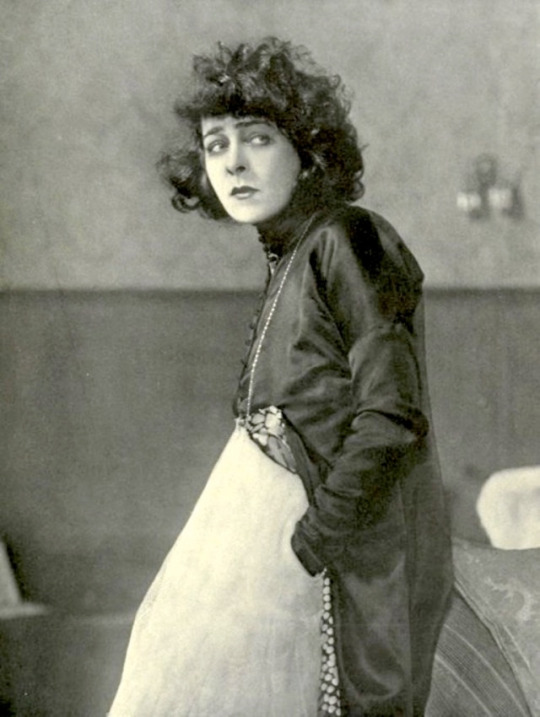
She was a proud lesbian, she was a director, she was artsy and experimental, she was instrumental in the rise to fame of Rudolph Valentino, she had the worlds biggest strap on energy

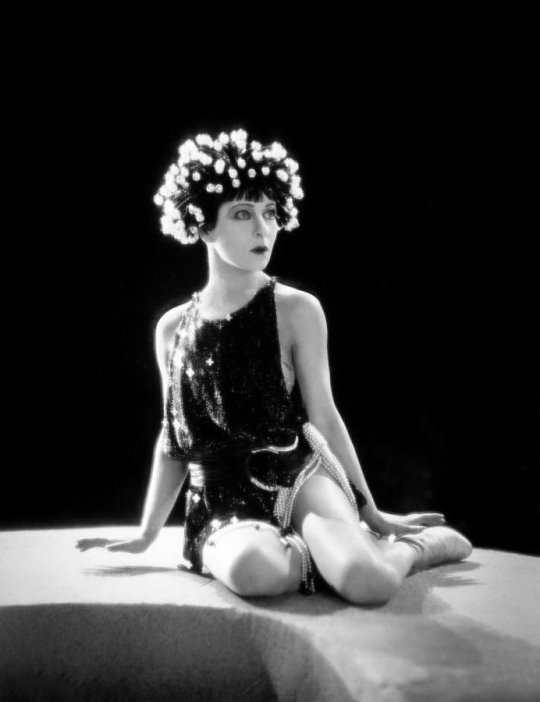
"Nazimova was primarily a star during the silent film era, and her career in film started when she was almost forty. She was openly bisexual, and was engaged in two lavender marriages during her life while she carried on relationships with women (including at least one, and possibly two, of Rudolph Valentino's wives). She was brilliant and an autodidact - when she first moved to the United States from Ukraine, she spoke no English, but taught herself "in about five months" and went on to work as a screenwriter (among other things). Her predilections lay in art film, and she's credited with starring in / producing / directing one of the first American art films, the adaptation of Oscar Wilde's play Salome (1923). She has an elegant and commanding presence in all of her films, and is an absolute sensation to watch in motion."
Gif link, another gif link

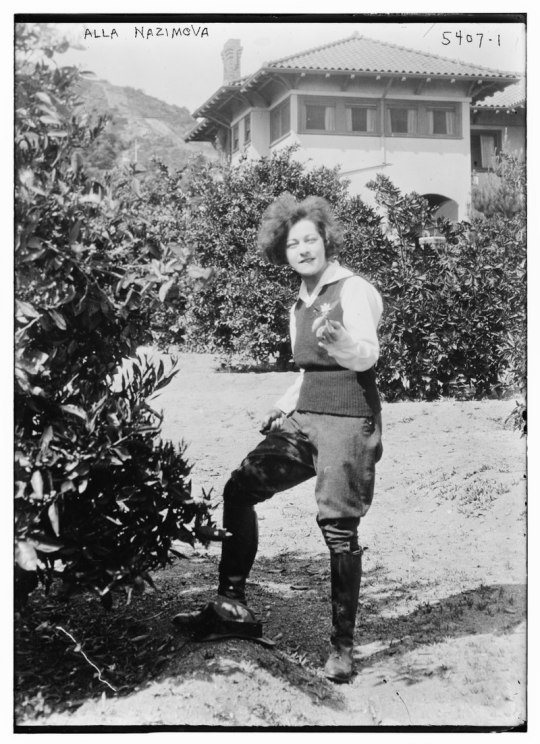
A great actress who also produced a great deal of her films, Nazimova is absolutely mesmerizing to watch. She was also bi and coined the phrase "sewing circle" for sapphic celebrities.

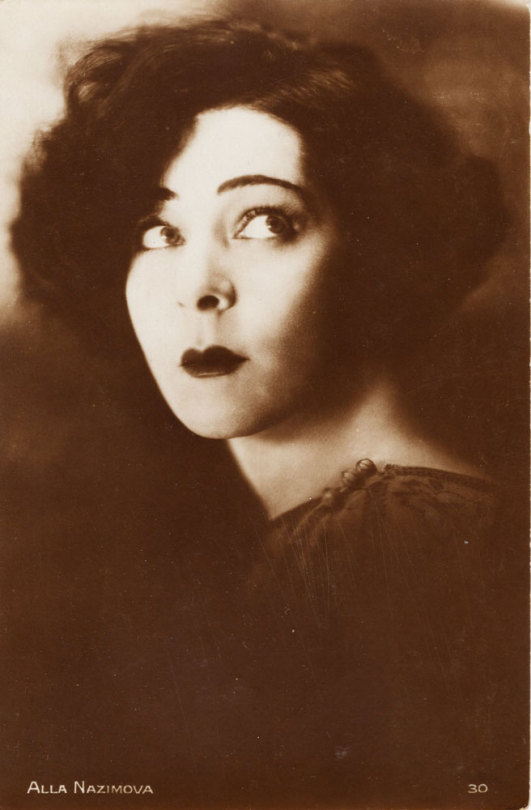

Olive Thomas propaganda:
Olive Thomas was one of the OG Hollywood starlets, and the only woman to seriously challenge Mary Pickford for Hollywood Queen supremacy. She was known for her stunning face and long ringlet hair, which is pretty amazing considering she was also the original flapper girl (so-called because of HER in the movie The Flapper!). She was also one of the first big Hollywood scandals, because her death was/is very suspicious and the idea that she might have died in a drunken accident (or been murdered by Mary Pickford's brother) was considered beyond the ability for "middle Americans" to understand. WE STAN A GORGEOUS MYSTERIOUS FLAPPER QUEEN!

108 notes
·
View notes
Photo




The Piazzetta Provenance Project
CFA: Raubkunst at the Ringling: A Catalogue in Absentia
Raubkunst at the Ringling: Franz Marc’s Schöpfungsgeschichtehas got a lot of attention. Surprisingly many responses have come from people who think they might be in possession of some Raubkunst themselves. I confer with two trusted colleagues on these tips, but we keep this information to ourselves. We’ve been tantalizingly close to some long-missing works we would all love to see returned to the public view.
I have found though that what most inquirers are seeking is not absolution but verification. I have been asked to authenticate two works by Franz Marc just in the past year. I am reluctant to do so in these conscience cases. For one thing, as the recent book by Stefan Koldehoff and Tobias Timm, Falsche Bilder Echtes Geld: Der Fälschercoup des Jahrhunderts - und wer alles daran verdientemakes clear, art forgers have become increasingly wily and technically proficient. The current interest in Provenienzforschunghas created almost as many opportunities for grift as the thieves and opportunist of the Third Reich did in the 1930s and 1940s. The well-meaning art historians who mistakenly declared the fakes by Wolfgang Beltracchi to be long-lost works by Georges Braque, Max Ernst and others have had their careers and reputations destroyed. There is a movement toward creating a professional standard for authenticating lost works, likely by a panel of experts in the work of the artist in conjunction with the formidable forensics of the Doerner Institut.
But for the moment in this respect we keep a low profile and our ears to the whispers in the wind.
While avalanches roar above, business continues below, on the tasks that canbe accomplished: reuniting artworks whose authenticity is unimpeachable with the families or museums to whom they once belonged. To that end, a researcher and writer is being sought to investigate the provenance of a quartet of quirkily shaped, sized, and framed 18th Century oil paintings associated with the work of Venetian artist Giovanni Battista Piazzetta (1682-1754). The genre pastoral scenes are in the collection of the John and Mable Ringling Museum of Art in Sarasota, Florida, having been purchased by the museum in 1949. The destination for this research is the collaborative book project Raubkunst at the Ringling: A Catalogue in Absentia, scheduled for publication in 2020. A worthy publisher and esteemed contributors are already aboard, though like me, their expertise is in Modernist art, hence our quest.
The Piazzetta-esque works were sold to the Ringling by the German-Jewish art, antique, and textiles dealer Adolph Loewi, who operated galleries in the Veneto as well as New York City and Los Angeles. In 1939 Loewi fled Italy with his family, losing some of his files in the process. Whether the documentation for the Piazzetta-adjacent works was among those documents is not clear; in any case, no record of their provenance exists prior to the Ringling purchase.
As I’ve noted, because the Modern Art that had been declared entartete– degenerate – by the Third Reich was seized by the Germans from German government-sponsored museums it is – technically – not considered Raubkunst, stolen art, though certainly the Nazis profited from its sale. Works that were stolen from private owners and collectors, or procured through forced sales, are truestolen objects, and subject to return to the families of their original owners.
Even in seemingly clear-cut cases, this process can be challenging. In many instances, entire families were murdered in their homes or in concentration camps, and no heirs exist to lay claim upon what should have been prized heirlooms. The few remaining survivors of Nazi art theft or their descendants must file official claims with the German government or bring private litigation against museums and auction houses. Claims to works must be substantiated by proof of ownership – a paradox that ends many legal proceedings before they begin since receipts, ledgers, diaries, and documentary stamps were often destroyed, dispersed, or concealed by those who had stolen the artworks in the first place.
Recent books such as Simon Goodman’s The Orpheus Clock: The Search for My Family's Art Treasures Stolen by the Nazis (2016) and The Lady in Gold: The Extraordinary Tale of Gustav Klimt's Masterpiece, Portrait of Adele Bloch-Bauer (2015) by Anne-Marie O’Connor detail the eventual triumph of the resourceful Goodman and Altmann families pitted against adversaries in museums and galleries over the course of lengthy and expensive court battles. Some cases turn less flamboyantly but more emotionally. The Austrian art dealer Lea Bondi-Jaray lost her beloved Portrait of Wally, a 1912 painting by her friend Egon Schiele, in the Anschluss in 1939. She went to her grave fighting to have the painting returned from private gallerist Rudolph Leopold who had acquired the painting in collusion with the Austrian government in 1954. Bondi-Jaray’s family continued the battle, eventually taking on no lesser adversaries than Ronald Lauder, the Museum of Modern Art, and Austria’s Leopold Museum. The case turned when the family produced pre-war photographs of Portrait of Wallyin Bondi-Jaray’s Vienna apartment, convincing the United States Customs Service to seize the painting and United States District Court for the Southern District of New York Judge Loretta A. Preska to allow the case to proceed to trial. The Leopold Museum settled with the family in 2010.
Because of their appealingly peculiar nature and the seeming completeness of the grouping of four, it seems likely that the Piazzetta workshop paintings came from a private collection. But whose? The task of the writer-researcher who takes on this investigation will be to unravel this mystery. The outcome may be as simple as a lost receipt establishing a chain of custody that puts the Ringling in the clear, or as profound as reuniting the quartet with a family who thought them lost decades ago.
I began this project in 2016 when I discovered two woodblock prints by the Blaue Reiterartist Franz Marc (1880-1916) in the Ringling collection, identified them as Raubkunst, and eventually traced them back to their original owners in Stuttgart and Mannheim. My findings were accepted as a “closed case” this past February by the Commission for Looted Art in Europe. So the investigation has since expanded in scope, to say the least. I would welcome collaboration with, as well as questions and advice from, members of the “Raubkunst Research” community. Contact me and I’ll get back to you. – Jean Marie Carey
Circle of Giovanni Battista Piazzetta 1682 -1754), Pastoral Scene, c. 1750. Oil on canvas, (56.5 x 92.7 cm). The John and Mable Ringling Museum of Art, Object number: SN627-SN630.
#Giovanni Battista Piazzetta#raubkunst#nazi looted art#john and mable ringling#ringling museum#sarasota#provenance#provenance research#cfa#cfp#art#art history#italian art#18th Century#rococo art#painting#collaboration#book project
25 notes
·
View notes
Photo

introducing... rudolph ❝ rudy ❞ abernathy.
🗽 looks like that’s RUDOLPH ABERNATHY reporting for duty. they’re originally from PORTLAND, OREGON, so i wonder if working as a LIEUTENANT for the FIRE DEPARTMENT OF NEW YORK ever gets old. anyway, i heard that they’re PERSONABLE but also kind of BOISTEROUS, which is why i guess they always remind me of A MISTY MOUNTAIN MORNING, THE COMFORTING BURN OF ALCOHOL, SOFT FLANNEL SHIRTS.
bio !
rudolph abernathy was born to the abernathys before they were ever married. he was the first of two other children.
rudy’s mother was a mechanic while his father was a librarian. as a child, rudy grew up with a great love of stories, a good knack for machines, and the forest for his backyard.
he’s always been adventurous, used to spend his afternoons exploring every inch of his sprawling backyard which never really ended, no matter how far he went.
his love for nature never waned as the years went by. at eighteen, rudy joined the national park services as a ranger for his nearest national park and loved every second of it. but even at his dream job, he felt restless. wanted to wander.
he asked for a transfer and ended up in a few different parks in the span of three years, never really satisfied with staying in one place too long.
during a stint in arizona, he got into the trade of firefighting and learning about types of fires in dry brush, containing it, procedures and protocols.
he ended up liking it more than he bargained for... which is what led to him quitting his job at the parks service and trying his hand out at firefighting.
from then on, he rolled from town to town making that his go-to, alternating it with parks services jobs as needed...
until one day the wind blew him into new york. he’d accumulated enough accolades and connections that he’s now a lieutenant for the fire department in manhattan
he’s only been around for a year at the most but it’s still one of his longest stops in a single town.
about !
rudy is a rolling stone. he never stays in one place too long and has been traveling across the united states basically since he was 21.
rides a motorcycle! takes very good care of it!
owns a dog! she’s a german shepherd and her name’s junebug and rudy takes a lot of pride in having trained her to like, obedience competition standards. they’ve never competed but he just liked having a well trained dog.
he puts junebug into a dog sidecar a lot. she has goggles and a helmet + bandana. pictures of her in it are p much All his camera is used for.
owns a cabin in upstate new york and stays there pretty much every time he’s free to drive up and enjoy nature. doesn’t hate the city but... he just likes the woods a lot better.
he’s very friendly, almost boisterous, kind of overly cheery, very chatty. could get on people’s nerves easily!
functional bisexual! star sign cancer!
pinterest here!
wanted connections !
dog friends --- as in, other people who have dogs. maybe that have doggy play dates or met at the dog park!
people he’s met on his journey --- given that he’s lived in a lot of places and that he’s incredibly friendly by nature, i’m guessing he’ll have a few of these??
fellow nature lovers --- imagine... they go upstate to fish one day... or to hike... make campfires?? look at sunsets?? what do nature freaks do idek man
nature haters --- i envision this as... someone he’s trying to convert into loving nature so he invites them along on hikes or fishing trips... they could absolutely hate it no matter what so you know.
people who think all his cheeriness is fake --- he’s always cheery, always chatty, always cracking jokes... and this could rub people the wrong way. so i think that’d be a fun dynamic tbh
motorcycle friends... --- just imagine them riding down the highway... skwad....
also... flings?? exes?? serious, almost married exes?? anything that brings drama into rudy’s life pls, THANK U
#dd.intro#° • ✧. • ◜ about → rudolph ◞#i sold lara my soul for her to make me graphics and it was WORTH IT
3 notes
·
View notes
Text
50 Awesome Women To Know: Part 4
You can find the other installments here. I am not willing to rule out the possibility that there may be more. For reasons.
Mae Jemison (1956 -- ), African-American, astronaut, first black woman in space, educator, holder of a B.Sc. in chemical engineering from Stanford University and an M.D. from Cornell. Dancer, holder of multiple honorary doctorates, founder of a technology company.
Margaret of Anjou (1430-1482): French, queen of Henry VI of England and powerful and ambitious figure in the Wars of the Roses. Probably the real-life model for Cersei Lannister in Game of Thrones (down to having a totally horrible son).
Margaret Sanger (1879-1966): American, founder of Planned Parenthood and the pioneer of the American birth control movement (for which she was subject to all kinds of shit). Controversial for her belief in a mild form of eugenics and association with racist figures, but absolutely worth knowing about.
Margery Kempe (c. 1373-after 1438): English, religious woman, mystic, traveler, and author of possibly the first autobiography in English, The Book of Margery Kempe.
Maria Anna Mozart (1751-1829): Austrian, older sister of Wolfgang, and just as talented as a musical prodigy and performer, but forced to give up her career and settle down when she got older. Unfortunately unable to separate herself from the control of their abusive and domineering father, Leopold.
Mary Fields (c.1832-1914): African-American, first black female mail carrier in the United States, a route she drove every week in rural 19th-century Montana. Also known as “Stagecoach Mary.” Shot racists in the butt and had a lifetime pass to drink in her local tavern. Generally took zero shit. Awesome.
Mary Wollstonecraft (1759-1797): English, writer, feminist, author of A Vindication of the Rights of Women among other works, career sadly cut short by her death in childbirth. Her daughter, Mary Shelley, is the author of Frankenstein and basically founded modern science fiction as a genre.
Maryam Mirzakhani (1977-2017): Iranian, mathematician and professor at Stanford, first female winner of the Fields Medal (the math Nobel Prize). Died at the age of just 40, from breast cancer.
Matilda of Tuscany (1046-1115): Italian, known as the “Great Countess,” powerful patron of Pope Gregory VII during the Investiture Conflict, and known for her skill on the battlefield, among other intrigues and politics.
Molly Brown (1867-1932): American, best known as the “Unsinkable Molly Brown” for her surviving of the Titanic sinking, but also an all-around awesome lady who worked to help poor children, was fluent in French, German, Italian, and Russian, an advocate for workers’ rights, and winner of the French Legion of Honor for her efforts to help wounded soldiers in WWI.
Naomi Klein (1970 -- ): French-Canadian, Jewish, left-wing activist and author of several books fiercely critiquing the destructive effects of runaway globalization, late-stage capitalism, and free-market economics, including No Logo and The Shock Doctrine.
Nonhelema (c.1718 -1786): Shawnee, chieftess and leader of her tribe, known as the “Grenadier Squaw” due to the fact that she stood six-foot-six and was famed as a warrior. Worked to contribute to the first dictionary of the Shawnee language and was an ally to white settlers, but she and her family were repeatedly screwed over by American soldiers (including the murder of her brother and husband), because of course they were.
Noor Inayat Khan (1914-1944): Indian, born in Russia, studied at the Sorbonne, poet and author became a spy and activist against the Nazis during World War II despite being a shy pacifist. Member of the Women’s Auxiliary Air Force and worked deep behind enemy lines. Captured and executed at Dachau concentration camp, at the age of just 30. First Muslim British war heroine.
Olympias of Macedonia (c.375-316 BC): Macedonian Greek, wife of Philip II of Macedonia and mother of Alexander the Great. Also a colorful character in her own right who was rumored to sleep with snakes. Was vampily played by Angelina Jolie in the 2004 film.
Rosalind Franklin (1920-1958): English, Jewish, scientist, chemist and researcher whose work on X-ray diffraction studies was crucial to the discovery of the structure of DNA (which Watson and Crick basically stole and never gave her credit). Died at just 37 from ovarian cancer.
Ruth Williams Khama (1923-2002): English/Botswanian, white British woman who married Seretse Khama, an African prince, in 1948, when interracial marriage was still very, very Not Done. Became the first First Lady of Botswana when he became president. Their story is told in the film A United Kingdom.
Samar Badawi (1981 -- ): Saudi Arabian, feminist and human rights activist, including challenging the guardianship rules, the ban on women driving and voting, and more. Received the 2012 International Woman of Courage award; was just arrested again (August 2018) by the Saudi government. Her brother, Raif Badawi, is also a blogger and liberal activist whose ongoing detainment is the cause of high-profile international attention.
Sappho (c.630-c.570 BC): Greek, poet and author, who was from the island of Lesbos, considerably admired in her own time, and whose work is well known for its exploration of same-sex female desire (including lending her name to the adjective Sapphic).
Sarah Churchill (1660-1744): English, the Duchess of Marlborough and one of the most influential women in late Stuart England, especially due to her long and close friendship with Queen Anne, which later fell out. Educated, strong-willed, stubborn, and could definitely hold a grudge.
Sor Juana Inés de la Cruz (1648-1695): Mexican, nun, scholar, philosopher, feminist, and author, whose feminist works and biting critique of religious hypocrisy and patriarchy brought her into conflict with the Catholic hierarchy of colonial Mexico. Died after contracting the plague caring for fellow nuns.
Sorghaghtani Beki (c.1190-1252): Mongolian, daughter-in-law of Genghis Khan, married to his youngest son. Like her sister-in-law Alakhai, she was a trusted and highly capable administrator, and may be one of the most powerful women in history for her development of the Mongol Empire.
Victoria Woodhull (1838-1927): American, first woman to run for president (in 1872), journalist, stockbroker, advocate for “free love” and women’s rights, civil rights and labor reforms, fought with noted killjoy Anthony Comstock, ran a newspaper with her sister Tennessee Claflin.
Vigdís Finnbogadóttir (1930 --): Icelandic, elected first female president of Iceland, and first female president in the world, in 1980. This followed the major Icelandic women’s rights movements of 1975, and she won despite being a divorced single mother. Again, in 1980. It’s hard to imagine that happening in America now. She served for 16 years and saw Iceland transform into possibly the most progressive country in the world in gender equality.
Virginia Hall (1906-1982): American, worked as a spy for the British Special Operations during WWII, and later for the CIA. Had an almost ludicrously colorful and eventful career, as well as a wooden leg that she named “Cuthbert.”
Wilma Rudolph (1940-1994): African-American sprinter and Olympic champion, who suffered from pneumonia, scarlet fever, and polio as a child (including having to wear leg braces until she was eight) and was the 20th of 22 children in a dirt-poor sharecropping family in the Deep South. First woman to win three gold medals in a single Olympics (1960 Rome).
139 notes
·
View notes
Photo
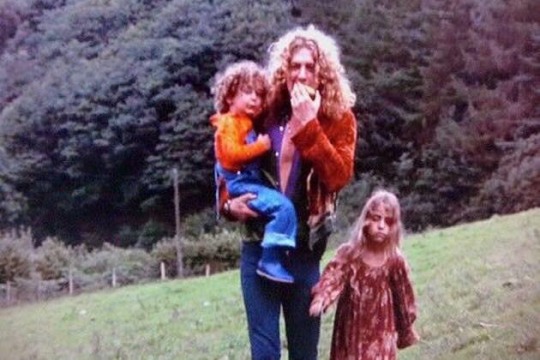
41 Years Ago: The Tragic Loss That Changed Led Zeppelin Forever by Jeff Giles Led Zeppelin appeared to lead something of a charmed existence during the early part of their career, enjoying blockbuster success with fans in spite of negative reviews from critics and quickly earning a spot near the top of the rock ‘n’ roll pantheon. But by the mid-’70s, they seemed to be suffering from a curse, as multiple setbacks kept them from capitalizing on the momentum they’d built – and on July 26, 1977, when singer Robert Plant suddenly lost his five-year-old son Karac to a stomach virus, it nearly split the band completely. The Plant family’s terrible tragedy came during what was supposed to be a triumphant American tour for Zeppelin. Two years earlier, the band had been forced off the road for an extended spell when Plant and his wife were involved in a serious car accident while visiting the Greek island of Rhodes. But even if the time off helped Plant recuperate from his injuries, it did nothing to prevent a series of disasters that dogged the tour, starting with Plant picking up a case of laryngitis that forced the group to push its first date back from February to April. Ticket sales were still strong, but the postponement had a ripple effect. As guitarist Jimmy Page later pointed out, the band’s equipment had already been shipped overseas, complicating any efforts to rehearse. “We didn’t have any instruments for a month,” he once lamented. “All the equipment was shipped over there five days before we were due to go. I didn’t play a guitar for a month. I was terrified at the prospect of the first few shows.” Once they were finally able to get out in front of fans, the problems continued to pile up. An April 1977 stop in Cincinnati was marred by violence when a group of ticketless fans tried to force their way into Riverfront Coliseum, and a “mini-riot” broke out after their June concert in Tampa ended up being rained out partway through the set. Things got even uglier the following month, when manager Peter Grant led a group – including drummer John Bonham – into the savage beating of a Bill Graham employee following their July 23 performance in Oakland, Calif. “There was an extraordinary amount of tension at the start of that tour,” a band employee later recalled. “It just got off to a negative start. It was definitely much darker than any Zeppelin tour ever before that time … The kind of people they had around them had deepened into some really criminal types. … They still had their moments of greatness (but) some of the shows were grinding and not very inspired.” After making their way out of Oakland, the band members made their separate ways to the next stop on the itinerary, a planned appearance in New Orleans. Shortly after arriving in the city, Plant received the devastating news, half a world away and helpless to join his son during his confusing final moments. “The first phone call said his son was sick,” said tour manager Richard Cole, describing a fateful pair of calls from Plant’s wife. “And the second phone call, unfortunately, Karac had died in that time.” “Karac was the apple of Robert’s eye; they idolized one another,” said Plant’s father in an Associated Press report announcing the immediate cancellation of the tour, which had been scheduled to run into August. Searching for answers about the sudden illness, Plant retreated home, taking comfort from his wife Maureen and daughter Carmen while Zeppelin went on hold. As Page later put it, “We were all mates. We had to give the man some space.” That didn’t mean Plant shut out his bandmates, however. “After the death of my son Karac in 1977, I received a lot of support from [Bonham], and I went through the mill because the media turned on the whole thing and made it even worse,” Plant told Barney Hoskyns. “I had to look after my family and at that time, as we regrouped, I applied to take a job at a Rudolph Steiner training college in Sussex. I wanted to just get out of it – to go away and forget it.” In a separate talk with Rolling Stone, Plant said “I lost my boy. I didn’t want to be in Led Zeppelin. I wanted to be with my family.” He also later claimed to have quit all of his chemical habits cold turkey. “I stopped taking everything on the same day,” Plant added. “The most important thing to me is my family and when I got off my face, I found it difficult to be all things to the people that meant a lot to me.” Plant was quite serious, at least for a time, about pursuing a new career in education, too. Admitting that “it’s not something that we, as a family, have been able to get over yet,” he told GQ in 2011 that “our family had always been close to the Rudolf Steiner Waldorf education in the West Midlands and I just liked the way it all worked. … I just thought there was something far more honest and wholesome about just digging in and putting the ego away in the closet. Because no matter what we say, entertainers are usually quite insecure, wobbly characters underneath – and maybe that bit of glory or that bit of expression or whatever it is compensates in some area. But I thought I should be rid of it. Yeah, I thought it was not a bad idea. Sometimes, I still feel like that.” In 2013, Plant remembered that “during the absolute darkest times of my life when I lost my boy and my family was in disarray, it was Bonzo who came to me. The other guys were [from] the South [of England] and didn’t have the same type of social etiquette that we have up here in the North that could actually bridge that uncomfortable chasm with all the sensitivities required … to console.” Zeppelin biographer Mick Wall took Plant’s comments a step further, claiming that the distance Robert Plant describes was even more profound — and that when Jimmy Page, bassist John Paul Jones, and Grant declined to appear at Karac’s funeral, it created a rift that never truly healed. “Until then, Robert was still in thrall to Jimmy and what he had created with Zeppelin. After that incident, Jimmy no longer held the same mystique for Robert,” Wall claimed in 2011. “It was also the beginning of Robert having much more power over what the band did or didn’t do next. He truly no longer cared and therefore was ready to walk at any point if they didn’t fit in with him. And that’s the way it remains to this day.” But if Bonham stayed closest to Plant’s side during the months following Karac’s death, it was ultimately Page who talked him out of retiring from music. “I was thinking about leaving the group, but Jimmy Page kept me from doing it,” Plant said in an interview at the time. “He said without me, the band’s nothing. He wanted me to take a break until I felt ready for playing again. I realized that we are more than business partners. We are real friends. We have enough money to live a life without troubles, but nobody knows how long our fans can wait. They might forget us if we don’t play anymore. I don’t want this to happen to the band. Our friends kept calling us every day. They helped us through this.” To Zeppelin fans’ everlasting regret, the road ahead for Zeppelin wouldn’t last much longer; although they soldiered ahead for 1979′s In Through the Out Door, Bonham’s sudden death on Sept. 25, 1980 ended the band as a creative unit once and for all. And although it’s impossible to know what they might have accomplished together if he hadn’t passed away, the group’s final days found them in an artistic flux, struggling to move forward while coming to grips with what they’d been through. “In Through the Out Door wasn’t the greatest thing in the world, but at least we kept trying to vary what we were doing, for our own integrity’s sake. Of all the records, it’s interesting but a bit sanitized because we hadn’t been in the clamor and chaos for a long time,” Plant pointed out in 1990. “In ’77, when I lost my boy, I didn’t really want to go swinging around. ‘Hey hey mama, say the way you move’ didn’t really have a great deal of import anymore.”
#led zeppelin#robert plant#karac plant#Carmen plant#in through the out door#1977#john bonham#bonzo#jimmy page#john paul jones#mick wall#peter grant#zeppelin history
118 notes
·
View notes
Text
Pioneer Architects IX
Modern culture in Mexico has found its filiation and origin in the personal isolation of its artificers, in which the Mexican is defined as the living conscience of it; from poet Sor Juana Inés de la Cruz to architect Luis Barragán. The authentic Mexican women revolution in architecture emerges from the separation from a guild that has always shown a profound historical conscience and ignored until then, the value of the doubt and the exam.

Courtyard of the el Eco. | Photo courtesy Museo Experimental el Eco
This traditionalism in the Mexican architecture and its ways, gave it strength and depth to these women and their forced isolation by the invisible walls of that same tradition, whose only exit (Barragán would later prescribe it) was a quiet revolution through the resurgence of the disciplinar reality and the conservative schemes of its long history. This secular isolation of women in the architectural field, provided them with a distant intelligence and a critical eye, that wasn’t in love with its particularities. For this issue of Pioneer architects, we find ourselves reflecting over the legacy of the solitary images of these pioneer architects, designers and historians, that shaped in different ways, the culture of design in Mexico in the XX Century, breaking their sound of silence.
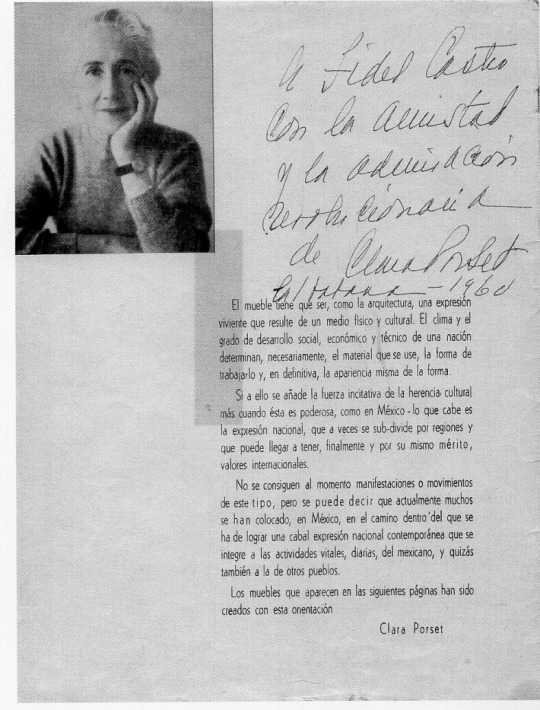
IRGSA with inscription from Clara Porset to Fidel Castro, 1960. | Photo via Salinas, Oscar. Una vida inquieta, una obra sin igual, UNAM, México, 2001
Such is the case of María Luisa Dehesa, the first Latin american architect to receive the degree in Mexico in 1937; Cuban industrial designer Clara Porset, who made her career in Mexico expanding the limits of Academia in the country and worked closely with Luis Barragan and Mario Pani; Nationalist promoter of the Mexican and first architect engineer from the National Polytechnic Institute Ruth Rivera Marín; North American Architecture Historian Esther McCoy whose fascination and critical view on Mexican Modernism would travel and impact the development of architecture and design in California; and first industrial designer, entrepreneur and promoter of Mexican modern design María Aurora Campos Newman.

Poster of the exhibition “El arte en la vida diaria”. | Photo via Salinas, Oscar. Una vida inquieta, una obra sin igual, UNAM, México, 2001
The real revolution of these women wasn’t to find the crack in the guild’s wall, knock down the doors of their academia, nor open the windows of the discipline searching for fresh air, openness, creative and professional freedom, questioning with their actions the absolute trust with which the old architects confronted the world from their own collegiate and groups. Their greatest merit, was to create themselves a world to live in and share it with us.
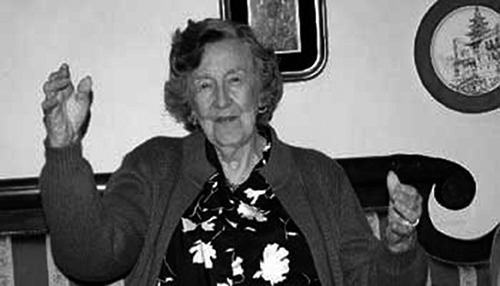
María Luisa Dehesa Gómez Farías (Mexico, 1912-2009) was the first woman to receive her architect degree in Mexico and Latin America, breaking the traditionally man-designated space on the discipline in the country. Her approach to architecture from a social perspective would be defined early on in her career when she proposed her thesis “Artillery Barracks Type” as a response to the high criminality among sons of soldiers that lacked a proper housing to share with their parent who remained quartered in the Barracks. Her proposal for the construction of a social family housing unit shaped her future projects and almost 50 year trajectory where she would continue to focus on housing in government dependencies on an urban scale in Mexico City’s Public Work Department.
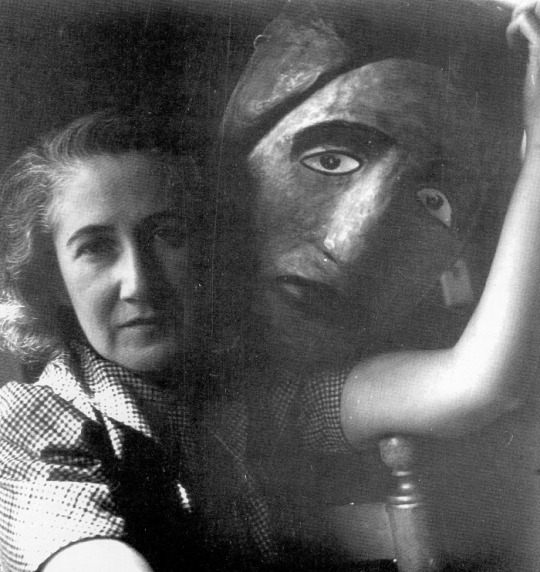
Clara Porset (Cuba, 1895-1981) was born in Cuba and became one the referent for Mexican design of the XX century. She studied architecture and furniture design in the Paris studio of Henri Rapin and attended classes at École des Beaux Arts, Sorbonne, and the Louvre. In 1934 she traveled to the United States to study under former Bauhaus instructors, artists Josef and Anni Albers at Black Mountain College. To her return to Cuba, she was briefly artistic director of the Technical School for Women, which she was forced to leave yet again due to her political stands. Back in Mexico, she married Mexican muralist Xavier Guerrero.

Clara Porset and Xavier Guerrero. | Photo via Salinas, Oscar. Una vida inquieta, una obra sin igual, UNAM, México, 2001
Her furniture designs would continue to be produced by Ruiz Galindo Industries (IRGSA) in the 50’s developing her E (wooden) and H (metal) - office furniture series. Porset later curated the exhibition Art in Daily Life: An Exhibition of Well-Designed Objects Made in Mexico at the Instituto Nacional de Bellas Artes in Mexico City in 1952, featuring handcrafted and mass-produced objects from local and international artists and designers.

Exhibition “El arte en la vida diaria” in Bellas Artes Museum, 1952. | Photo via Salinas, Oscar. Una vida inquieta, una obra sin igual, UNAM, México, 2001
By the end of the 50’s she returned this time to post-revolutionary Cuba to design the new society furniture visions of the revolutionaries in schools and universities.

Exhibition “El arte de la vida diaria” in UNAM 1952. | Photo via Salinas, Oscar. Una vida inquieta, una obra sin igual, UNAM, México, 2001
She returned to Mexico then to teach Art History at the recently founded Industrial Design Program at the Universidad Nacional Autónoma de México, where she settled part of her legacy in Mexican Modern Design through her personal collection, library and archive.

Clara Porset’s chairs in the Julius Shulman studio in California, 1952. | Photo via Salinas, Oscar. Una vida inquieta, una obra sin igual, UNAM, México, 2001

Clara Porset and Xavier Guerrero, Low Cost Design Competition Drawings, Museum of Modern Art. | Photo via Salinas, Oscar. Una vida inquieta, una obra sin igual, UNAM, México, 2001
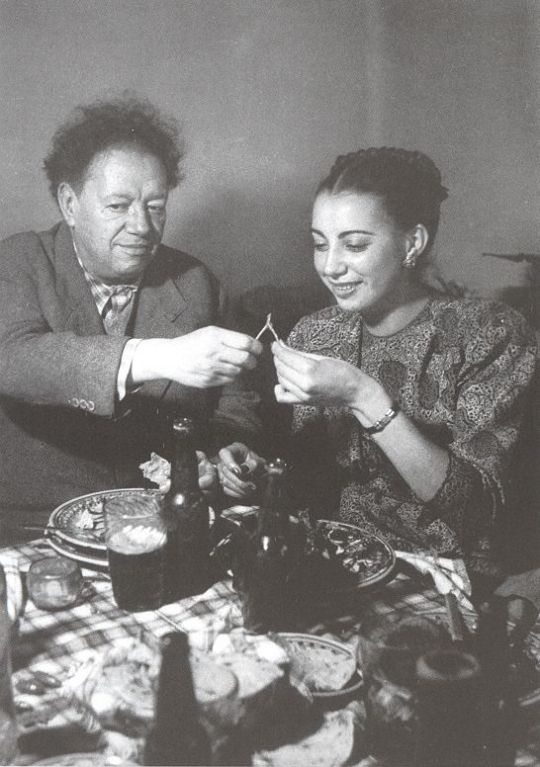
Diego Rivera and Ruth Rivera. | Photo via Fototeca Nacional
Ruth Rivera Marín (Mexico, 1927-1969) was the first woman to graduate from the College of Engineering and Architecture at the National Polytechnic Institute in Mexico in 1950. Daughter of Mexican renowned muralist Diego Rivera and well-known actress and writer Guadalupe Rivera Marín, she was early on introduced to the world of the arts and culture. She studied urban rehabilitation in Rome after working in the master plan for the city of Celaya, Guanajuato for the public service. She then returned to Mexico to teach architecture Theory, Architectural Composition and Urban Planning Theory, and furthering her intellectual acumen and nationalist ideal working closely with Diego Rivera and architects Juan O’Gorman, Pedro Ramírez Vázquez and Enrique Yañez.

Anahuacalli Museum in Mexico City. | Photo courtesy of Museo Anahuacalli
By the 1960’s she became head of planning for the Ministry of public Education’s National Systems of Regional Rural School. Rivera would later be involved on the building of the national Medical Center and the Museum of Modern art in close collaboration with Pedro Ramírez Vázquez; as well as with Luis Barragan on the Museum ‘El Eco’ in Mexico City. Her most noted work was the Anahuacalli Museum in association with Diego Rivera and Juan O’Gorman; and her design for the Mexican Pavilion for the 1962 Century 21 Fair in Seattle alongside Carlos Mijares. Rivera then ran Notebooks of Architecture and Conservation of the Artistic patrimony and its supplement Notebooks of Architecture, a journal of theory and practice in the discipline that was the basis for teaching in the XX Century in Mexico.

Anahuacalli Museum under construction. | Courtesy of Museo Anahuacalli

Mexican Pavilion Interior at the Seattle World's Fair Exposition in 1962. | Photo by postcard Ebay

Esther McCoy (USA, 1904-1989) was an American architecture critic and historian, instrumental in bringing the modern architecture of California to the world, shaping modernism in Los Angeles. Contributor to the magazine’s Arts & Architecture, Architectural Forum, Architectural Record, Progressive Architecture; the Los Angeles Times and The Los Angeles Herald-Examiner, as well as European journals L'Architectura and Lotus; her writing was a leading critical voice in a male-dominated architecture community, tracing the now well constructed Californian modernism identity.

Archives of American Art: Cuernavaca, ca. 1950 | Esther McCoy papers (1876-1990), bulk 1938-1989; Archives of American Art, Smithsonian Institution
However, less known is her contribution and broadcast of Mexican Modernism to California. During the year-long period spent in Mexico in 1951, her writing and observations of the vibrant and contextual modernist scene developing in Mexico during the 50’s; while drawing the references and connection in the design language and spatial articulation that architects from both places used, building a bridge between Mexico and California, the international and popular style, Luis Barragán and Rudolph Schindler, Clara Porset and Richard Neutra. During her trips to Mexico, she witnessed the construction of Mario Pani and Enrique del Moral Universidad Nacional Autónoma de México Campus, the domestic architecture of Luis Barragán, Juan O-Gorman, and Francisco Artigas, key figures of the the modernization in the country and brought them to an audience that knew little about it.
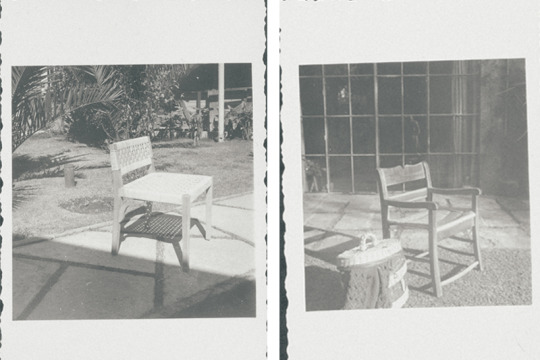
Research photographs: Furniture and Crafts, ca. 1950 | Esther McCoy papers, 1876-1990; bulk 1938-1989; Archives of American Art, Smithsonian Institution
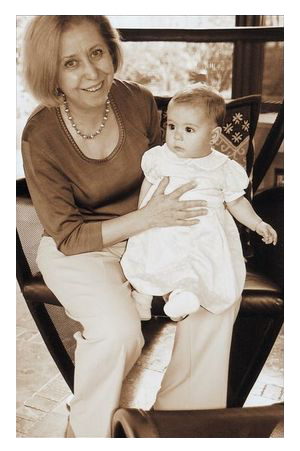
María Aurora Campos Newman de Díaz with her son. | Photo via Grupo di
María Aurora Campos Newman de Díaz (1941-2003) was the first Mexican woman in the country to graduate as industrial designer from the Universidad Iberoamericana in 1962 with a thesis on packaging for children beauty products. Inspired by her time working at the projects department at Knoll International, she left to Italy in 1965 to continue her studies at the Politecnico di Milano, and then to Germany in 1967 to study at the renowned Universität Ulm. After the school’s definite closing in 1968, she returned to Mexico in 1969, where she became famous for her commitment to promote design as founder of Grupo di in 1971, a company devoted the office-interior space planning, and designated Knoll’s distributed in Mexico until 1985.

Recepetion oak wooden desk with chromed steel base. | Photo via Grupo di
Among her most renowned projects of her, was the new image for the international executive lounge for Mexicana de Aviación in Mexico City’s international airport; a project incorporating in the interior design, and integral way to incorporated furniture, exhibition stands, finishings and technology, opening a field of corporate interior design. In 1983, Campos Newman founded DA COLOR, a pioneer store in Mexico specialized in self-build furniture made by national designers. By 1988 Grupo di started importing Italian furniture and becoming the exclusive distributor in the country for Estel, Arflex, Matteograssi and Reixte; until 1999, from where she developed her own office furniture line, produced entirely in Mexico, Euro. Her entrepreneurial labor and integral philosophy towards design, carried an important role in the development and promotion of Mexican modern design.


International Executive Lounge "Mexicana de aviación", Mexico City International Airport. | Photo via Grupo di
---

by Tania Tovar Torres
157 notes
·
View notes
Photo

Ghosts of Hollywood
Even after death, some Hollywood celebrities can’t stop putting in appearances
Marilyn Monroe
The Hollywood Roosevelt Hotel on Hollywood Boulevard is said to be the current residence of several ghosts of popular film stars. Marilyn Monroe, the glamorous and funny star of such pictures as Some Like It Hot and Gentlemen Prefer Blondes, was a frequent guest of the Roosevelt at the height of her popularity. And although she died in her Brentwood home, her image has been seen on several occasions in a full-length mirror that once hung in her poolside suite. The mirror has been relocated to the hotel’s lower level by the elevators.
Montgomery Clift
Another respected star who died before his time, Montgomery Clift, was a four-time Oscar nominated actor who is best known for his roles in A Place in the Sun, From Here to Eternity and Judgment at Nuremberg. His ghost has also been seen at the Roosevelt. According to some of the hotel’s staff, Clift’s spirit haunts room number 928. Clift stayed in that suite in 1953, pacing back and forth, memorizing his lines for From Here to Eternity. Loud, unexplained noises have been heard coming from the empty suite, and its phone is occasionally found mysteriously off the hook.
Perhaps it’s fitting that the Hollywood Roosevelt should be the stirring place of celebrity ghosts since it was the site of the very first Academy Awards ceremony in 1929. In fact, the Blossom Ballroom, where the ceremony was held, has an unexplained cold spot – a circular area measuring 30 inches in diameter that remains about 10 degrees colder than the rest of the room.
Harry Houdini
Houdini is best known as a magician and escape artist, of course, but at the height of his fame he was also drawn to Hollywood, where he made a handful of silent films from 1919 to 1923. With such titles as The Man from Beyond and Haldane of the Secret Service (which he also directed), the films were not regarded well enough to give him much of a Hollywood career. Houdini’s interest in the occult was well known, and although he earned a reputation as a masterful debunker of séances, he earnestly sought contact with those who have passed on to the other side. Shortly before his death, Houdini made a pact with his wife Bess that if he could, he would return and make contact with her from the other side. Perhaps he truly has attempted to return. Some claim to have seen the ghost of the great Houdini walking around in the home he owned on Laurel Canyon Blvd. in the Hollywood Hills. Film historians Laurie Jacobson and Marc Wanamaker, in their book Hollywood Haunted, dispute this story, saying that “Houdini most likely never even set foot in the Laurel Canyon mansion he is said to haunt.”
Clifton Webb
Clifton Webb was a very popular star of the 1940s and ’50s, earning two Oscar nominations for his roles in Laura and The Razor’s Edge. He may be best known for his portrayal of Mr. Belvedere in a series of films. It’s not too often that a ghost haunts the place in which the person is buried, but this seems to be the case for Webb. His ghost has been seen at the Abbey of the Psalms, Hollywood Memorial Cemetery, where his body is interred. But it seems to be a restless spirit, as his ghost has also been encountered at his old home on Rexford Drive in Beverly Hills.
Thelma Todd
Thelma Todd was a hot young star in the 1930s. She was featured in a number of hit comedies with the likes of The Marx Brothers, Laurel and Hardy, and Buster Keaton. But that all ended in 1935 when Todd was found dead in her car, which was parked above the café she owned on the Pacific Coast Highway. Strangely, her death was ruled an accidental suicide, but many suspected murder and a coverup by powerful Hollywood figures. The building that once housed the café is now owed by Paulist Productions, and employees have reportedly witnessed the starlet’s ghost descending the stairs.
Thomas Ince
Ince is considered one of the visionary pioneers of American movies. He was one of the most respected directors of the silent era, best known, perhaps, for his westerns starring William S. Hart. He partnered with other early Hollywood giants such as D.W. Griffith and Mack Sennett, and founded Culver Studios, which later became MGM. Ironically, Ince’s death overshadowed his film legacy. He died aboard William Randolph Hearst’s yacht in 1924, and although the official record shows the cause of death as heart failure, the hot rumor is that he was shot by Hearst in a fit a jealousy over Hearst’s wife, Marion Davies. Ince’s ghost – as well as several other ghostly figures – have been seen in the lot that was once Culver Studios. Film crew members have seen the specter of a man matching Ince’s description on several occasions; in one instance, when the workers tried to speak to the spirit, it turned and disappeared through a wall.
Ozzie Nelson
Ghosts and hauntings are the last thing that come to mind when you think of the perpetually cheerful Ozzie and Harriet Nelson. The couple, with their real-life sons Ricky and David, were stars of the long-running sitcom “Ozzie and Harriet,” noted for its good-natured, gentle humor. Yet poor Ozzie doesn’t seem to be as contented in the afterlife. Family members, it is said, have seen Ozzie’s ghost in the family’s old Hollywood home, and it always appears to be in a somber mood. Perhaps he’s unhappy about how another Ozzy and his family have gained notoriety on TV.
George Reeves
From 1953 to 1957, George Reeves was TV’s Superman. Reeves had been around Hollywood for a while, playing bit parts in such films as Gone with the Wind and dozens of B-movies, but it was “The Adventures of Superman” on TV that brought him fame. Reeves died of a gunshot at his home in 1959. The official cause of death was suicide, but that conclusion has been hotly disputed, with some believing that Reeves was murdered. Whether it was suicide or murder, Reeves ghost has been seen in his Beverly Hills home. A couple claims to have seen the ghost of Reeves – decked out in his Superman costume – materialize in the bedroom where he died, after which it slowly faded away.
Others believe that Reeves succumbed to the “Superman curse,” in which those associated with the fictional character over the years allegedly have met with disaster or death. But is there really a curse? Read “The Truth About the Superman Curse” by Superman expert Brian McKernan.
More Celebrity Ghosts
Rudolph Valentino – This silent film heartthrob has been seen in the bedroom and stables of his old Hollywood home.
Jean Harlow – The spirit of this blonde bombshell is said to haunt the bedroom of her home on North Palm Drive, where her husband allegedly used to beat her.
Mary Pickford – This legend of the silent era – actress, writer and producer – was co-founder of United Artists with her husband Douglas Fairbanks and Charlie Chaplin. Comic Buddy Rogers, who lived in the house Pickford once owned, saw her ghost appear in a white ruffled dress.
Grace Kelly – Princess Stephanie of Monaco believes that the ghost of her mother, Grace Kelly, helped her write a song from the spirit world.
Celebrities Who Have Seen Ghosts
Nicholas Cage – This Oscar-winning actor (Leaving Las Vegas) refused to stay in uncle Francis Ford Coppola’s home after seeing a ghost in the attic. (Cage was also cast as Superman in director Tim Burton’s film project, which was never made.)
Keanu Reeves – The star of The Matrix films and Devil’s Advocate was just a kid in New Jersey when he saw a ghost that took the form of a white double-breasted suit come into his room one night. He wasn’t imagining it; his nanny saw the phantom, too.
Neve Campbell – She’s been in more than her share of paranormal-themed movies (The Craft, Scream), but she’s had real-life encounters as well. A woman was murdered in the house she now lives in, and friends have seen her ghost walking around.
Matthew McConaughey – This popular actor (Contact) says he freaked out the first time he saw the ghost of an old woman, whom he calls “Madame Blue,” floating around his house.
Tim Robbins – Robbins, who was nominated for an Oscar in Mystic River, didn’t see ghosts, but strongly felt their presence when he moved into an apartment in 1984. Following his instinct, he moved out the next day.
Hugh Grant – British romantic comedy lead Hugh Grant (Love Actually) says he and friends have heard the wailing and screaming of some tormented spirit in his Los Angeles home. He even speculates it might be the ghost of a former resident – Bette Davis.
Dan Aykroyd – The Ghostbusters star (and Oscar-nominated for Driving Miss Daisy) has long had a fascination with the paranormal. He believes his home, once owned by Cass Elliot of The Mamas and The Papas, is haunted. “A ghost certainly haunts my house,” he said. “It once even crawled into bed with me. The ghost also turns on the Stairmaster and moves jewelry across the dresser. I’m sure it’s Mama Cass because you get the feeling it’s a big ghost.”
Sting – Rock star Sting (Lock, Stock and Two Smoking Barrels) and his wife Trudie have seen ghosts in their home. “I was absolutely terrified,” he said. “I now believe those things are out there, but I have no explanation for them.”
Jean Claude Van Damme – The Belgian action star (Timecop), also known as “Muscles from Brussels,” swears he saw a ghost in his bathroom mirror while he was brushing his teeth.
Richard Dreyfuss – He won an Oscar for The Goodbye Girl, but at one time had a cocaine problem. Visions of a ghost, he said, helped him kick the habit. “I had a car crash in the late 1970s,” Dreyfuss said, “when I was really screwed up, and I started seeing these ghostly visions of a little girl every night. I couldn’t shake this image. Every day it became clearer and I didn’t know who the hell she was. Then I realized that kid was either the child I didn’t kill the night I smashed up my car, or it was the daughter that I didn’t have yet. I immediately sobered up.”
Ethan Hawke and Uma Thurman – This Hollywood couple was forced to flee their “dream home” in Sneden’s Landing, N.Y. when it became all too apparent that it was haunted. They still are reluctant to talk about their frightening encounters.
Belinda Carlisle – This pop singer and founding member of The Go-Gos, who appeared in Swing Shift and She’s Having a Baby, says she saw a “misty shape” hovering over her as she lay in bed one night. She also says that when she was 17, while nodding off to sleep in a chair in her parents’ home, she levitated and had an out-of-body experience.
Elke Sommers – This German-born actress, who appeared in the 1966 film The Oscar, claims to have seen the ghost of a middle-aged man in a white shirt in her home in North Beverly Hills. Guests in her home have also seen the specter. So much paranormal activity was reported in the house that the American Society for Psychical Research was brought in, and which verified the unexplained events. The severely haunted house was bought and sold more than 17 times since Sommers vacated it, and many have reported ghostly phenomena.
Paul McCartney – Ex-Beatle and Oscar-nominated songwriter (“Live and Let Die”) says that he, George Harrison and Ringo Starr sensed the playful spirit of John Lennon when they were recording Lennon’s song, “Free As A Bird” in 1995. “There were a lot of strange goings-on in the studio – noises that shouldn’t have been there and equipment doing all manner of weird things. There was just an overall feeling that John was around.”
9 notes
·
View notes